Florida’s diverse waterways are a treasure trove not only for birdwatchers like me but also for fishing enthusiasts. The state’s rich aquatic habitats—from serene freshwater lakes to vibrant coastal reefs—are home to an incredible variety of species. If you share my passion for exploring nature, you’ll find that learning about the types of fish in Florida adds a whole new dimension to outdoor adventures.
As someone who often combines birdwatching with fishing trips, I’ve come to appreciate the incredible biodiversity beneath the water’s surface. From the prized largemouth bass in freshwater ponds to the spectacular sailfish off the coast, Florida’s fish species are as fascinating as the birds that soar above. Identifying these fish not only helps in angling but also deepens your connection to Florida’s ecosystems.
This guide features 75 of the most common and interesting types of fish in Florida, complete with pictures and identification tips. For anglers aiming to improve their catch or nature lovers eager to learn more, this list will enhance outdoor experiences and inspire a deeper appreciation for Florida’s natural beauty.
Freshwater Fish in Florida
Largemouth Bass (Micropterus salmoides)
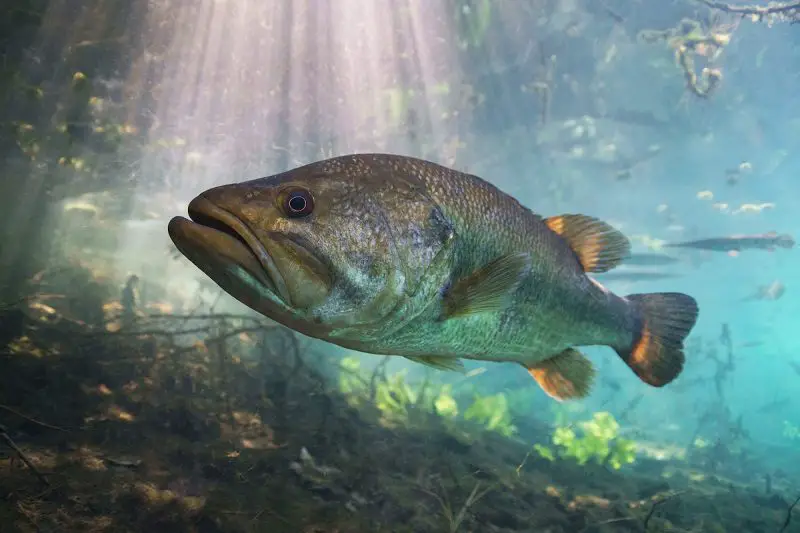
The largemouth bass is one of the most iconic freshwater sport fish in North America, particularly abundant in Florida’s lakes, rivers, and canals. It has a robust, elongated body with a deep green coloration on the back that fades to lighter green or white on the belly. The most distinctive feature is its large mouth that extends past the eye when closed, giving the fish its common name.
Largemouth bass can be identified by the dark, horizontal stripe running along their sides and their spiny dorsal fin separated slightly from the soft-rayed rear portion. Adult fish typically range between 12 to 24 inches long but can grow even larger in Florida’s warm, nutrient-rich waters. They are highly sought after by anglers for their aggressive strikes and fighting power.
In Florida, largemouth bass thrive in a wide range of freshwater environments, including ponds, lakes like Lake Okeechobee, and slow-moving rivers such as the St. Johns and Suwannee. They prefer areas with submerged vegetation, fallen logs, and other structures that offer ambush opportunities. As ambush predators, their diet consists mainly of smaller fish, frogs, and crustaceans.
Suwannee Bass (Micropterus notius)
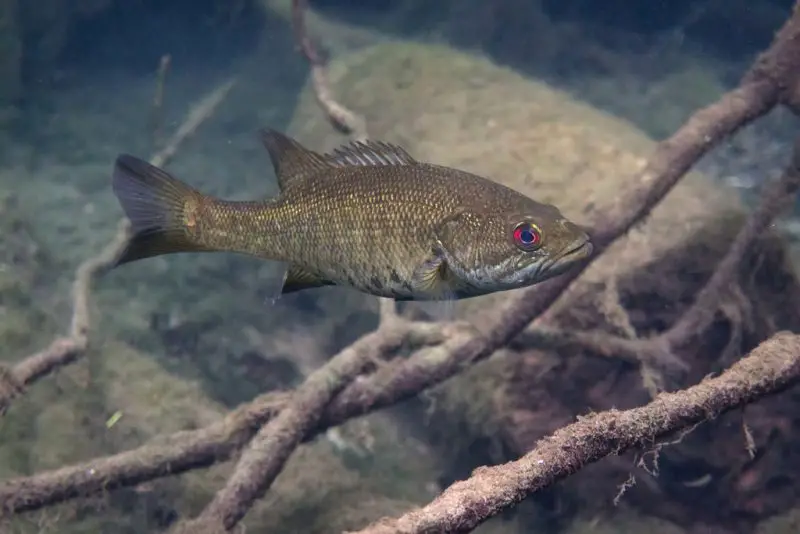
The Suwannee bass is a lesser-known black bass species that is native only to a few river systems in northern Florida and southern Georgia, most notably the Suwannee and Santa Fe Rivers. It is smaller than the largemouth, usually reaching only 12 to 16 inches in length, and has a more compact, muscular body suited for river currents.
It can be identified by its dark olive color with bronze highlights, irregular vertical bars on its sides, and turquoise coloring on the edges of its fins and around the eyes. Unlike the largemouth, the Suwannee bass has a smaller mouth that does not extend past the eye and a continuous dorsal fin without separation.
This species prefers clear, spring-fed rivers with rocky or sandy substrates and moderate to swift currents. It often hides behind rocks or other submerged structures and feeds on insects, small fish, and crayfish. Though less common than other basses, the Suwannee bass is valued by anglers seeking a unique, native catch in Florida’s Panhandle region.
Shoal Bass (Micropterus cataractae)
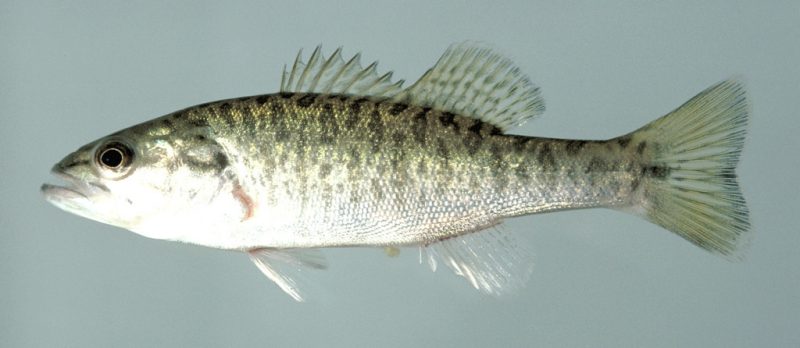
The shoal bass is a rare and localized black bass species, not native to much of Florida but found in the extreme northwestern part of the state, near the Chattahoochee River system. It resembles a smallmouth bass in shape but differs in coloration and genetics. Adult shoal bass generally grow to about 12–18 inches long and have a streamlined body built for river currents.
This species features a bronze to greenish-brown body with dark vertical bars and scattered spots below the lateral line. One of the key identification features is the presence of a patchy dark blotch on the gill cover and no tongue patch, which helps differentiate it from other bass. The tail fin often has a light-colored edge.
Shoal bass favor fast-flowing, rocky-bottomed streams and rivers where they utilize eddies and riffles for cover and feeding. They are highly sensitive to habitat loss and water pollution, making them an important species for conservation. In Florida, their range is limited, and they are most often found in river systems that extend from Georgia into the far north of the state.
Bluegill (Lepomis macrochirus)

Bluegill is one of the most common and widespread sunfish species in Florida’s freshwater ecosystems. Recognized for their deep, pan-shaped body and distinctive dark spot at the rear base of the dorsal fin, bluegills are often found in schools around structures like vegetation, docks, and submerged trees. Their body coloration ranges from bluish-green on the back to yellow or orange on the belly.
They can be identified by the dark vertical bars along their sides and a small black ear flap on the operculum (gill cover). Males become more vibrantly colored during the breeding season, showing orange throats and brighter bellies. Bluegills typically measure between 4 to 8 inches but can grow larger in productive waters.
Bluegills inhabit lakes, ponds, rivers, and canals throughout Florida, especially in warm, still or slow-moving waters. They feed on small insects, larvae, plankton, and occasionally small minnows. Known for their aggressive bite and abundance, bluegills are a favorite among beginner and seasoned anglers alike, especially during their spawning season when they gather in large beds in shallow waters.
Redear Sunfish (Lepomis microlophus)
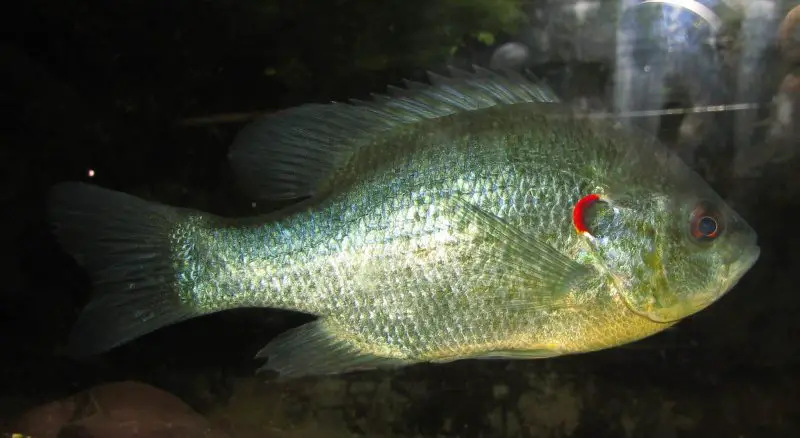
Redear sunfish, also called “shellcracker,” are closely related to bluegill but are known for their strong jaws adapted for crushing snails and mollusks. They are typically larger than bluegills and can reach lengths of 10 to 12 inches or more. Their name comes from the noticeable red or orange edge on the opercular flap, especially in males.
The body of a redear sunfish is olive to greenish-brown with faint vertical bars and a yellowish belly. They lack the distinct dark spot on the dorsal fin seen in bluegills. These fish are more bottom-oriented and are often found in deeper, vegetated areas of lakes, canals, and rivers.
Redear sunfish are distributed widely across Florida and thrive in clear waters with sandy or muddy bottoms. Their diet includes aquatic snails, insect larvae, and other invertebrates. Anglers appreciate them not only for their size and fight but also for their excellent table quality. They are especially active during spring spawning months, when they move into shallows to build nesting beds near bluegill colonies.
Spotted Sunfish (Lepomis punctatus)

The spotted sunfish, often called “stumpknocker,” is a small but colorful member of the sunfish family commonly found in Florida’s freshwater habitats. It typically reaches lengths of 4 to 6 inches, though some individuals may grow slightly larger. The body is deep and laterally compressed, displaying a dark brown to olive-green coloration with numerous small black or dark brown spots scattered along the sides.
These fish are easily identified by their distinctive dark spots on the body and fins, especially the anal and dorsal fins. A black ear flap with a reddish margin is present, though less pronounced than in other sunfish. Their compact size and spotted pattern help them blend into submerged logs, roots, and aquatic vegetation, where they find both food and shelter.
Spotted sunfish are native to most of Florida’s slow-moving rivers, swamps, and backwater streams. They prefer areas with submerged wood and dense cover. Their diet consists of aquatic insects, crustaceans, and small snails. Despite their small size, they are popular among light-tackle anglers due to their tenacious fight and widespread presence in warm, vegetated waters.
Warmouth (Lepomis gulosus)
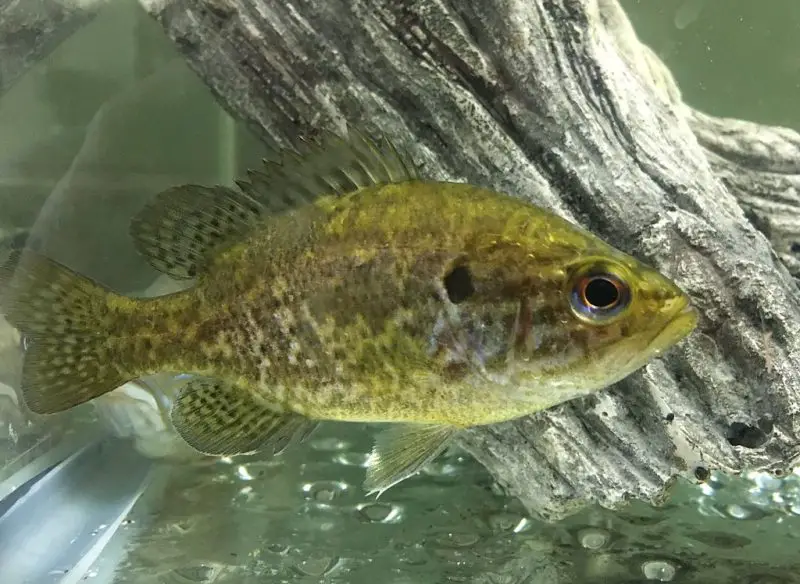
The warmouth is a robust sunfish species with a large mouth and a thick body, giving it a bass-like appearance. It usually grows between 6 to 10 inches long, though larger specimens are occasionally caught. Its coloration is dark olive or brown with a marbled pattern of darker lines and blotches, often accompanied by reddish eyes and streaks on the cheeks.
A key identification trait is its large mouth, which extends to beneath the eye, and the three to five distinct reddish lines radiating from the eyes across the cheeks. Warmouths also have a dark spot at the base of the dorsal fin and short, rounded pectoral fins. These features distinguish them from other sunfish species with smaller mouths and brighter colors.
Warmouth are found throughout Florida in lakes, canals, swamps, and sluggish streams, especially in places with heavy vegetation or debris for cover. They are hardy fish that tolerate low-oxygen environments and turbid waters. Their diet is varied and includes insects, small fish, crayfish, and even frogs. Warmouth are aggressive predators and will strike artificial lures, making them a fun catch for anglers targeting panfish.
Black Crappie (Pomoxis nigromaculatus)
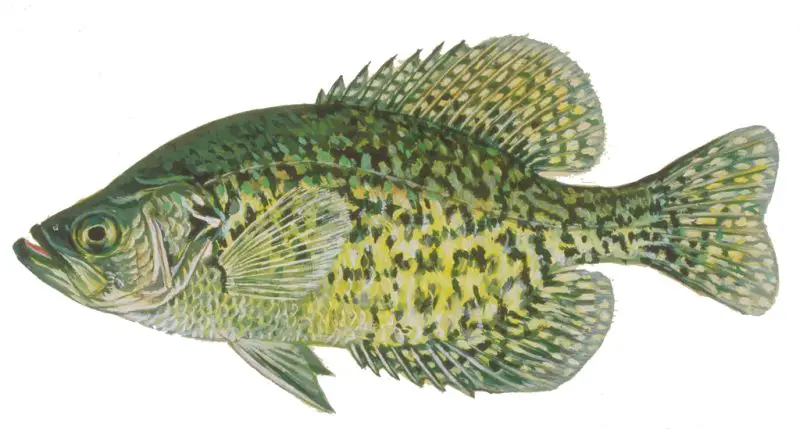
The black crappie is a popular panfish in Florida, known for its excellent taste and popularity among sport anglers. It typically measures 8 to 12 inches in length but can grow larger under ideal conditions. The body is laterally compressed with a silvery base color covered in numerous dark, irregular blotches that give it a mottled appearance.
It can be distinguished from the similar white crappie by the absence of vertical bands and the presence of 7 to 8 dorsal fin spines, compared to 5 or 6 in the white crappie. Black crappies also have a more rounded body and a smaller mouth. Their dorsal and anal fins are almost mirror images of each other, and both are marked with dark spots.
Black crappie inhabit clear, vegetated lakes, slow-moving rivers, and reservoirs throughout Florida. They prefer cooler water temperatures than many other sunfish and congregate in deeper areas during hot months. Their diet includes small fish, insects, and crustaceans. In the spring, they move to shallower water to spawn, often building nests near submerged structures. Night fishing with minnows and jigs is a popular method for catching them.
White Crappie (Pomoxis annularis)
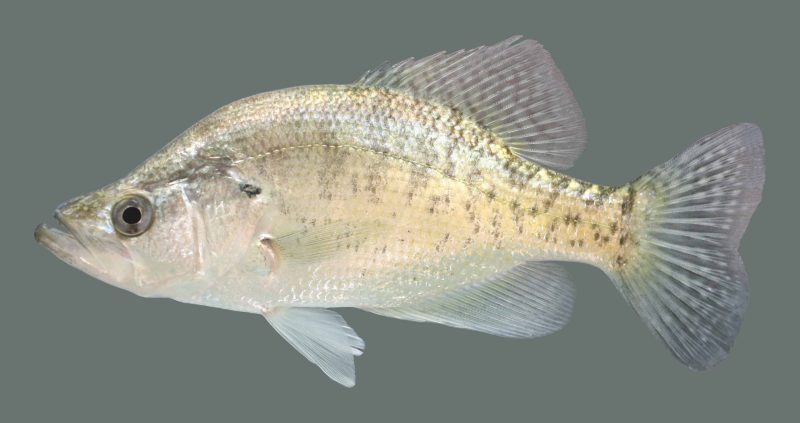
The white crappie is slightly more elongated than the black crappie and is less common in Florida but still found in certain freshwater systems. It typically reaches lengths of 8 to 14 inches and is known for its silvery-white body with 5 to 10 vertical dark bands running along its sides. The head is slightly more sloped than that of the black crappie, and the mouth is relatively large.
One way to distinguish it from the black crappie is by counting the dorsal fin spines—white crappie have only 5 or 6, compared to the black crappie’s 7 or 8. The white crappie also has a more elongated body shape and lighter patterning, making it easier to identify when the two species are found in overlapping habitats.
In Florida, white crappie are typically found in rivers, lakes, and reservoirs with warmer, turbid waters, especially in the Panhandle and northern regions. They favor slow currents and are often located around submerged timber, brush piles, and docks. Like their black crappie relatives, white crappie feed on small fish, insects, and zooplankton. They are excellent table fare and are highly prized during their spring spawning run when they move into shallow water in large schools.
Channel Catfish (Ictalurus punctatus)
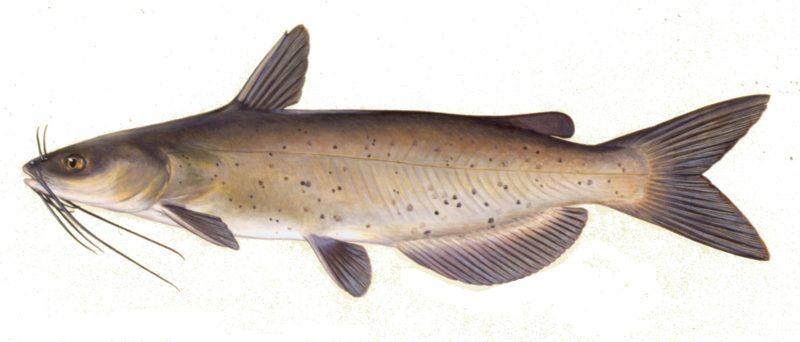
The channel catfish is one of the most widespread and popular freshwater catfish species in Florida. It is recognized for its slender body, deeply forked tail, and smooth, scaleless skin. Adults range in size from 12 to 30 inches or more, with coloration varying from bluish-gray to silvery sides and a whitish underside. The body is often marked with small dark spots, especially in younger individuals.
A notable feature of the channel catfish is its four pairs of barbels or “whiskers” around the mouth, which help it detect food in murky water. It has a curved anal fin with 24 to 29 soft rays and a slightly notched caudal fin. Unlike flathead or blue catfish, the channel catfish lacks a pronounced upper lobe on the tail fin and usually has a narrower head.
Channel catfish are found in freshwater lakes, rivers, ponds, and even brackish estuaries across Florida. They prefer clean to moderately turbid water and are bottom dwellers, often active during the evening and nighttime hours. Their diet includes insects, crustaceans, fish, and various plant material. They are highly adaptable, which makes them common in both natural habitats and stocked fisheries, and they are a favorite among both recreational and commercial fishers.
White Catfish (Ameiurus catus)

The white catfish is the smallest member of the large catfish family that includes channel and blue catfish. Typically reaching lengths of 12 to 24 inches, it has a stocky body, broad head, and a distinctly forked tail. Its coloration ranges from slate blue to pale gray with a white or silvery underside, and its skin is smooth and scaleless.
This species is easily identified by its short, rounded anal fin with 19 to 23 rays and a relatively broad head compared to other catfish. It has four pairs of barbels around the mouth, with the chin barbels usually white or pale in color. Unlike the channel catfish, the white catfish lacks dark spots on the body and has a more compact build.
White catfish are found in slow-moving rivers, lakes, ponds, and brackish estuaries across Florida, especially in the central and northern regions. They are highly adaptable to a range of salinities and prefer muddy or sandy bottoms with cover like submerged logs. Feeding mostly at night, their diet includes insects, crustaceans, small fish, and organic debris. They are prized for their mild-tasting meat and are commonly caught by anglers using live or cut bait.
Flathead Catfish (Pylodictis olivaris)
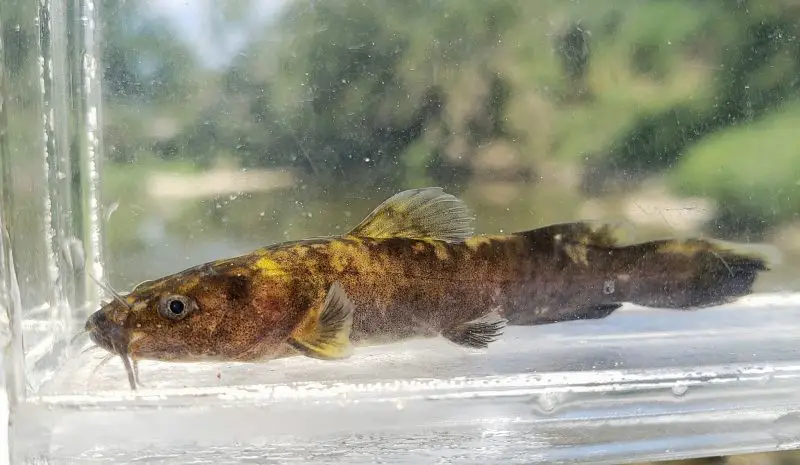
The flathead catfish is a large, predatory species known for its broad, flattened head and powerful build. It can grow quite large, often exceeding 40 inches in length and weighing over 50 pounds. Its coloration is typically mottled brown or olive with a pale yellow to white belly, which helps it blend into the river bottom.
One of the most distinguishing features of the flathead is its squared tail fin, in contrast to the deeply forked tails of other catfish. It also has a protruding lower jaw and a broad, flat head that gives it a shovel-like appearance. Its body lacks the small dark spots seen in channel catfish and is more uniformly mottled or blotchy.
Flathead catfish are found mainly in the Panhandle and northern parts of Florida in large rivers, reservoirs, and deep channels. They prefer slow-moving or still waters with plenty of submerged structure. Unlike many other catfish that scavenge, flatheads are active predators that feed on live fish, especially sunfish and shad. They are mostly nocturnal and favored by trophy anglers due to their size and strength.
Brown Bullhead (Ameiurus nebulosus)

The brown bullhead is a small, hardy catfish species with a chunky body and a rounded tail. It usually grows between 10 to 14 inches in length and is recognized for its mottled brown or yellowish body with a creamy underside. This fish thrives in murky, slow-moving waters and can tolerate low oxygen levels, making it highly adaptable.
Brown bullheads can be identified by their squared tail fin, short anal fin with 21 to 24 rays, and eight distinct barbels around the mouth. The chin barbels are usually dark brown or black, which helps distinguish them from yellow bullheads. Their scaleless skin and compact body help them move easily through thick aquatic vegetation and mud.
This species is widespread across Florida in ponds, canals, swamps, and small lakes. Brown bullheads are bottom feeders that consume insects, crustaceans, detritus, and small fish. They are especially active at night and are often caught using worms or cut bait. Though not typically targeted as a sport fish, they are appreciated for their resilience and occasional use in home aquariums or small-scale aquaculture.
Yellow Bullhead (Ameiurus natalis)

The yellow bullhead is a medium-sized catfish that commonly measures 8 to 14 inches in length. It has a rounded tail and a plump, smooth-skinned body that is yellowish-brown to olive green on top with a pale yellow or white belly. It often looks similar to the brown bullhead but has a brighter and more uniform coloration.
This species can be identified by its pale or yellowish chin barbels, which contrast with the dark barbels of the brown bullhead. Its anal fin has 24 to 27 soft rays, and the tail is more rounded than forked. The yellow bullhead has a blunt snout and small eyes, and its barbels help it forage along the bottom in murky environments.
Yellow bullheads are found in nearly all types of freshwater habitats across Florida, from lakes and slow rivers to ditches and marshes. They are very tolerant of low oxygen and poor water quality, making them common in stagnant or muddy waters. Yellow bullheads feed on insects, mollusks, detritus, and aquatic plants. They are often caught by anglers using stink bait or worms and are considered good eating due to their firm, mild-flavored flesh.
Florida Gar (Lepisosteus platyrhincus)

The Florida gar is a primitive, torpedo-shaped fish known for its long body and bony, elongated jaws filled with sharp teeth. It commonly grows between 20 to 34 inches in length and has a dark olive to brown coloration with irregular round black spots scattered along the body, fins, and snout. Its tough, ganoid scales give it an armored appearance and protect it from predators.
This gar is easily identified by its broad snout, which is shorter and wider than that of the longnose gar. It has a single dorsal fin located far back on the body and a rounded tail fin. The spots on its body are more numerous and evenly distributed compared to other gar species, and juveniles often have a distinct lateral stripe.
Florida gars are found in slow-moving rivers, swamps, canals, and freshwater marshes throughout the Florida peninsula and parts of southern Georgia. They prefer shallow, vegetated waters where they can ambush prey such as small fish, insects, and crustaceans. Florida gars can breathe atmospheric air using a modified swim bladder, allowing them to survive in warm, oxygen-poor waters. While not typically targeted for sport, they are intriguing native fish with a unique appearance and ancient lineage.
Longnose Gar (Lepisosteus osseus)
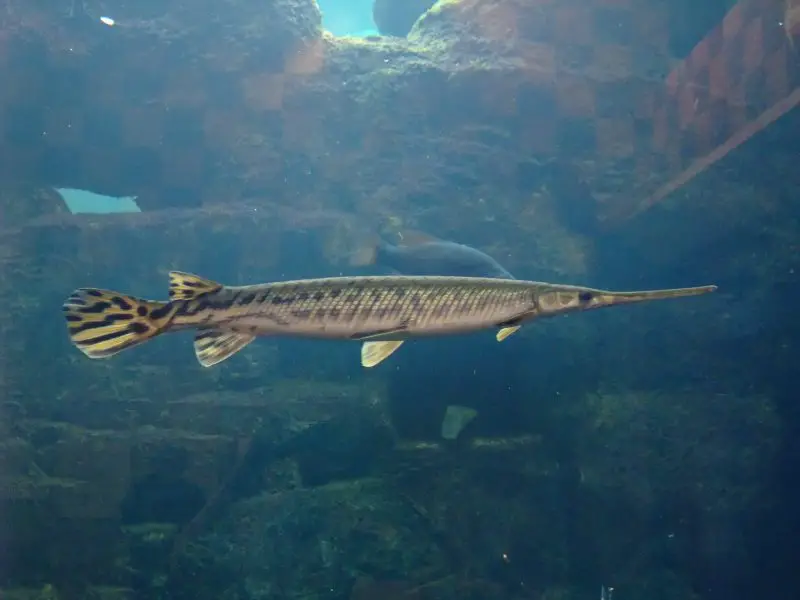
The longnose gar is a slender, prehistoric-looking fish known for its extremely long, narrow snout filled with sharp teeth. Adults typically reach 28 to 48 inches in length, with a dark green or brown back and light, spotted sides. Its body is covered in hard, diamond-shaped ganoid scales that offer strong protection and give it a distinctive armored look.
This species is easily recognized by its long beak-like snout, which is much longer than the width of its head and can be more than twice the length of its skull. Black spots appear on its fins and tail, and it has a long, cylindrical body with a dorsal fin located near the tail. Unlike the Florida gar, the longnose gar has fewer spots and a much narrower snout.
Longnose gar are widely distributed across Florida, particularly in the Panhandle, central lakes, and slow-moving rivers. They prefer clear, weedy backwaters where they can hover quietly near the surface. These ambush predators feed on fish and crustaceans and can gulp air to survive in oxygen-poor environments. Though rarely eaten, they are sometimes caught by anglers using live bait and are appreciated for their unique, ancient appearance.
Bowfin (Amia calva)
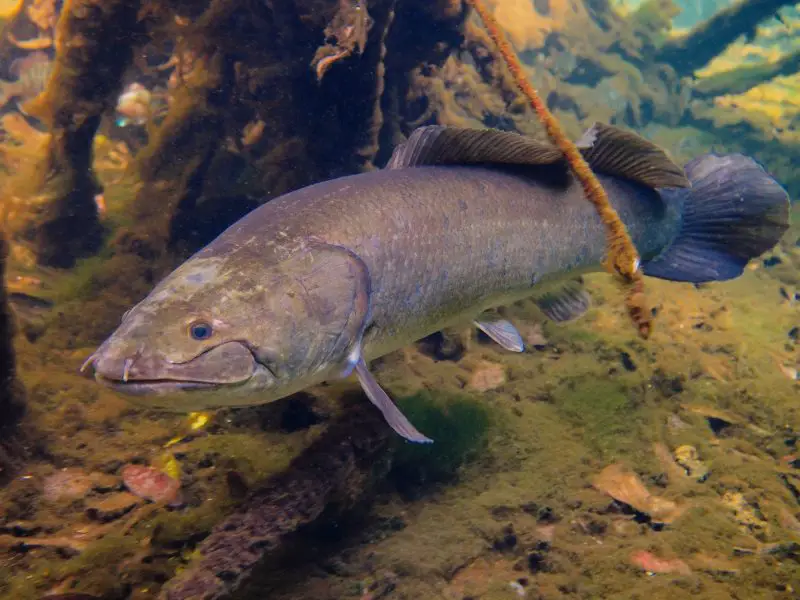
The bowfin is a stout, muscular fish with a long, cylindrical body and a continuous dorsal fin that extends nearly the length of its back. Adults usually grow between 18 and 30 inches but can exceed 30 inches in favorable conditions. Their coloration is dark green or brown with a pale underside, and males often have a distinctive black eyespot near the tail.
This fish is often confused with snakehead species due to its body shape and long dorsal fin, but it can be distinguished by its rounded tail and robust head with strong jaws. The bowfin has a bony plate under its lower jaw and a short anal fin. Juveniles and males often display a pronounced eyespot that helps distract predators away from the head.
Bowfin inhabit sluggish rivers, swamps, canals, and weedy lakes throughout Florida, thriving in areas with heavy vegetation and soft bottoms. They are air breathers, capable of surviving in warm, oxygen-depleted water using a gas bladder that functions like a lung. Bowfins are aggressive predators that feed on fish, amphibians, and invertebrates. Though not commonly targeted by sport anglers, they put up a strong fight when hooked.
Chain Pickerel (Esox niger)

The chain pickerel is a sleek, torpedo-shaped fish known for its aggressive strikes and sharp teeth. It typically reaches 15 to 24 inches in length and has a greenish body marked with a distinctive chain-like pattern of dark lines along its sides. Its snout is long and flat, and it has a large mouth with fang-like teeth suited for grabbing prey.
Identifying features include a vertical black bar beneath each eye and a deeply forked tail. Its dorsal fin is set far back on the body, and its narrow shape allows for quick, explosive movements in pursuit of prey. Unlike its larger relatives like the northern pike, the chain pickerel is smaller and more common in southern waters.
This species is found throughout Florida in vegetated lakes, rivers, and blackwater swamps. It prefers weedy areas where it can ambush prey, including small fish, frogs, and insects. Chain pickerel are popular among light-tackle anglers due to their quick, aggressive nature. While their flesh is edible, it contains many small bones, so they are not typically considered a favorite food fish.
Golden Shiner (Notemigonus crysoleucas)
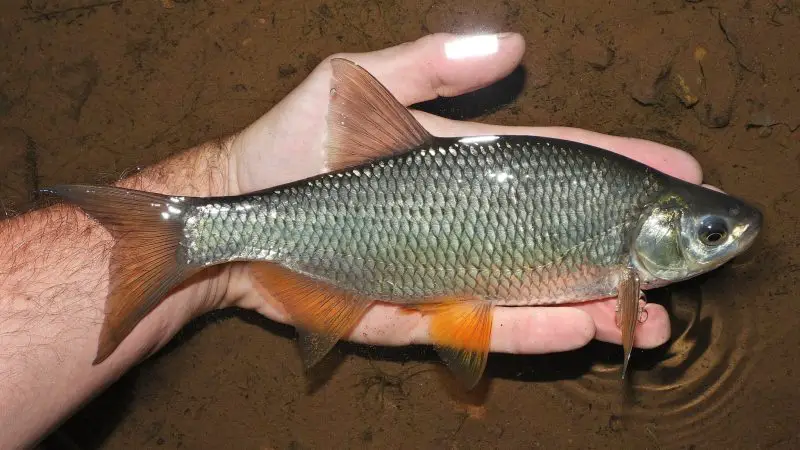
The golden shiner is a small, deep-bodied baitfish that commonly measures 4 to 6 inches in length, though it can grow up to 12 inches. Its body is laterally compressed and covered in shiny, golden-bronze scales that give it a vibrant appearance in sunlight. The fish has a small, upturned mouth and a relatively short dorsal fin.
Golden shiners are identified by their deep, flattened shape, golden coloring, and scaleless keel that runs from the pelvic fins to the anal fin. Unlike other minnows, they have a curved lateral line and lack spines in the fins. Their tail is forked, and the fins may be slightly reddish or pale.
These fish are widespread throughout Florida and are found in lakes, ponds, canals, and slow rivers with abundant vegetation. They are omnivores that feed on plankton, algae, insects, and detritus. Golden shiners are best known as live bait for larger game fish like bass and pike. Because of their tolerance to varied water conditions and rapid reproduction, they are also commonly used in aquaculture and as forage in stocked ponds.
Eastern Mosquitofish (Gambusia holbrooki)
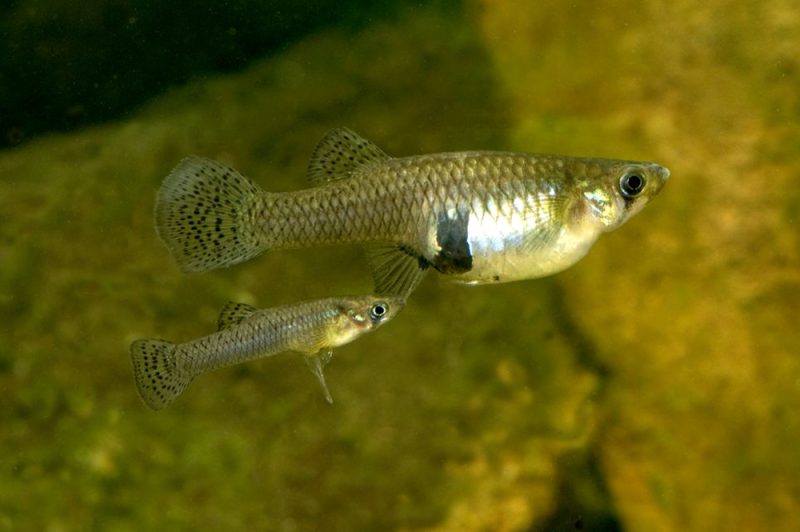
The eastern mosquitofish is a small, hardy fish with a short, rounded body, typically measuring 1 to 2.5 inches in length. Females are larger than males and have a gray to olive coloration with a rounded tail and a belly that may become distended when gravid. Males are smaller, more slender, and possess a modified anal fin called a gonopodium used for reproduction.
Mosquitofish are easily recognized by their blunt snout, upturned mouth, and lack of striking coloration. Their plain appearance is offset by their active behavior and tolerance of a wide range of environmental conditions. They are livebearers, giving birth to free-swimming young rather than laying eggs.
These fish are found statewide in almost every freshwater habitat, including ditches, ponds, marshes, canals, and even brackish waters. Eastern mosquitofish feed primarily on insect larvae, especially mosquitoes, making them valuable for mosquito control. They are often introduced into water bodies to help manage insect populations. Despite their usefulness, they can become invasive and outcompete native species when overpopulated.
Sailfin Molly (Poecilia latipinna)

The sailfin molly is a small, colorful fish known for the male’s large, fan-like dorsal fin that resembles a sail. These fish are generally 2 to 4 inches long, with males being more vividly colored and adorned with spots or iridescent hues ranging from blue to green. Females are plainer and larger-bodied, often with a silvery appearance and subtle patterning.
Easily distinguished by the prominent, high-rising dorsal fin in males, the sailfin molly also has a rounded tail and a blunt head with an upturned mouth adapted for surface feeding. It is a livebearer, meaning females give birth to fully formed young. These fish are closely related to guppies and other popular aquarium species, sharing similar reproductive behavior.
Sailfin mollies are found in fresh and brackish waters across Florida, particularly in coastal marshes, canals, ponds, and slow-moving streams. They are highly tolerant of varying salinity and temperature, allowing them to thrive in a wide range of habitats. Sailfin mollies feed on algae, detritus, and small invertebrates. Due to their adaptability and attractiveness, they are often kept in aquariums and studied in ecological research.
Speckled Killifish (Fundulus chrysotus)
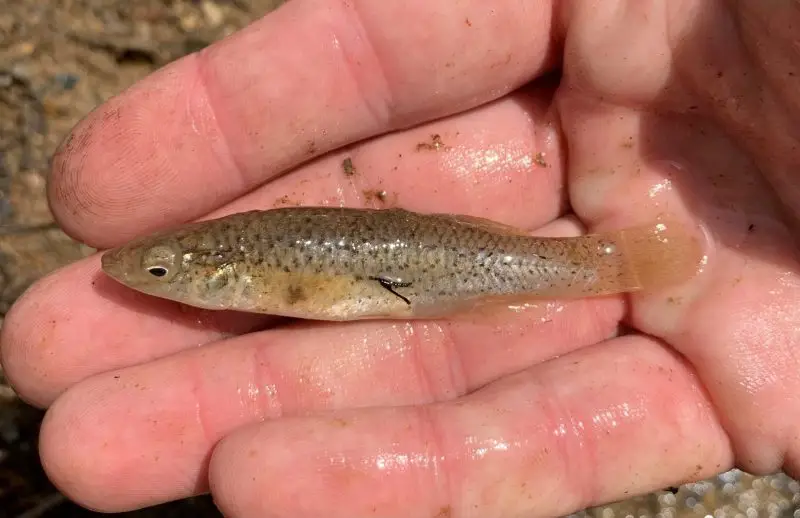
The speckled killifish is a small, native Florida species that rarely exceeds 3 inches in length. It has a slim body with a rounded tail and a silvery or olive-colored base adorned with iridescent blue or gold speckles. Males tend to be more colorful and may display red or orange markings during the breeding season.
This fish is identified by its speckled pattern, blunt snout, and upturned mouth. It also features a small dorsal fin set far back near the tail. The speckled killifish is well adapted to feeding at the water’s surface and is known for its rapid, darting movements. During reproduction, males become more vividly colored to attract females.
Speckled killifish inhabit shallow freshwater and brackish environments throughout Florida, including marshes, ditches, tidal creeks, and roadside canals. They are hardy and can tolerate low oxygen levels, variable salinity, and even temporary droughts. Their diet includes mosquito larvae, small insects, and algae. These fish play a vital role in mosquito control and serve as forage for larger fish and birds.
Brook Silverside (Labidesthes sicculus)
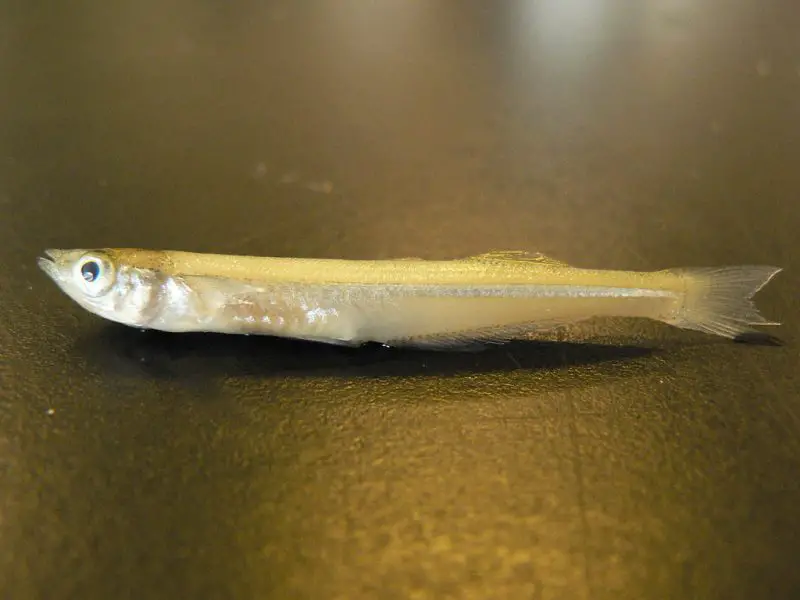
The brook silverside is a slender, translucent fish with a silvery stripe running along its side, helping it blend into the shimmering light of freshwater environments. Adults grow up to 5 inches long and have a slightly upturned mouth and a small, forked tail. Their clear fins and elongated body give them a delicate appearance.
Brook silversides are easy to identify by their silvery lateral stripe and glassy, semi-transparent body. They have two dorsal fins, with the first being small and spiny, and their eyes are large and well-adapted to spotting surface-dwelling prey. Their movements are quick and erratic, making them difficult targets for predators.
This species is found in lakes, clear rivers, and reservoirs throughout Florida, especially in areas with abundant aquatic vegetation. Brook silversides feed near the surface, consuming insects, zooplankton, and other small organisms. They are important as a forage species for game fish such as bass and crappie and are indicators of good water quality due to their preference for clean, oxygen-rich habitats.
Grass Carp (Ctenopharyngodon idella)
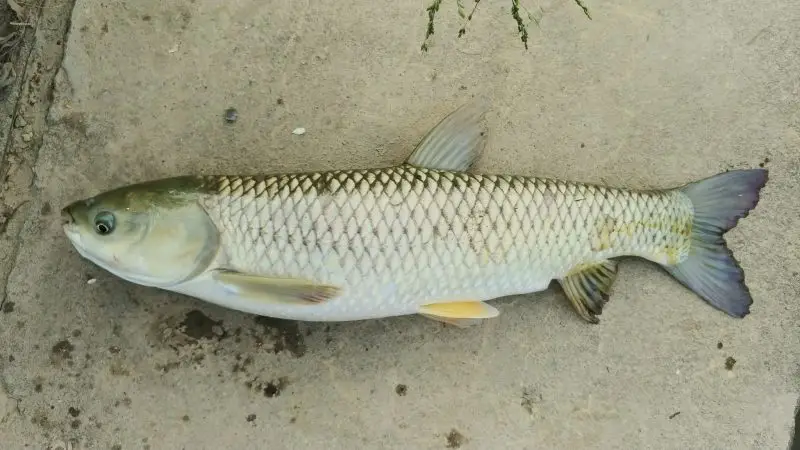
The grass carp is a large, herbivorous fish native to Asia but introduced to Florida for aquatic vegetation control. It can grow over 4 feet long and weigh more than 60 pounds. The body is long, cylindrical, and covered in large, dark-edged scales, giving it a torpedo-like appearance. The coloration is typically grayish green on the back and silvery on the sides.
Unlike native carp, the grass carp has no barbels and a shorter, more rounded head. Its mouth is slightly downturned, well-suited for grazing on aquatic plants. It is a non-breeding species in Florida unless artificially spawned, making it a controllable biological tool for vegetation management in water bodies.
Grass carp are widely stocked in Florida lakes and canals to control invasive aquatic plants like hydrilla and duckweed. While they are effective in reducing vegetation, they can also alter habitats and displace native species, earning them an invasive classification. Their diet consists almost entirely of plant material, and while they are sometimes fished for sport, they are more commonly used in water management programs.
Walking Catfish (Clarias batrachus)
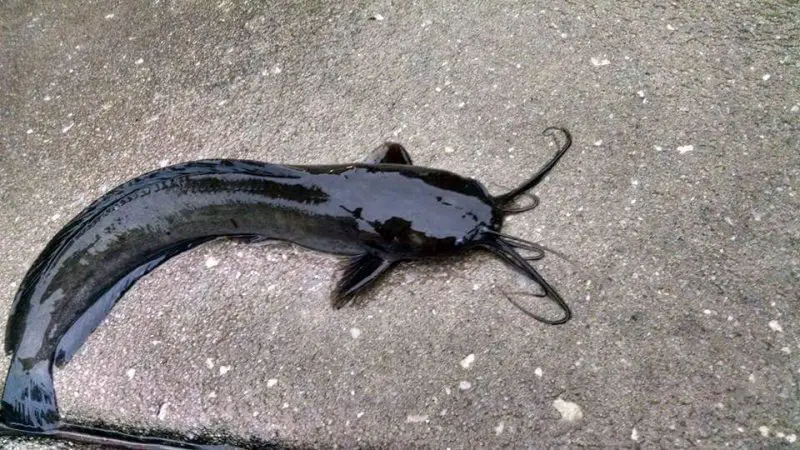
The walking catfish is a non-native, invasive species in Florida, known for its ability to move across land using its pectoral fins and breathing air through a specialized organ. It typically grows 12 to 18 inches in length and has a smooth, scaleless body with a long dorsal fin, broad head, and whisker-like barbels.
This catfish is easily recognized by its mottled gray to brown coloration, flattened head, and long, eel-like body. Its air-breathing adaptation allows it to survive in oxygen-poor waters and even travel between water bodies during wet conditions. Its movements on land are aided by strong, spiny pectoral fins that allow it to “walk.”
Walking catfish are now found throughout southern and central Florida, especially in canals, ditches, and small ponds. They compete with native species for food and space and can overwhelm ecosystems when populations grow unchecked. They feed on a wide variety of organisms, including insects, detritus, small fish, and plant material. Due to their invasive nature, it is illegal to transport or release walking catfish in Florida without special permits.
Oscar (Astronotus ocellatus)

The Oscar is a large, colorful cichlid native to South America but now invasive in Florida waters. It typically grows 12 to 18 inches long, with a robust, oval-shaped body. Oscars display vibrant coloration that can include shades of orange, red, black, and white, often with distinctive eye-like spots on the tail fin which serve as a defense mechanism to confuse predators.
Oscars are easily identified by their thick lips, large eyes, and unique patterning that varies widely among individuals. Their body is laterally compressed, and the dorsal and anal fins extend toward the tail. Known for their intelligence and aggressive behavior, Oscars are popular aquarium fish but become problematic when introduced to non-native ecosystems.
In Florida, Oscars inhabit canals, ponds, and slow-moving rivers, often competing with native fish for food and habitat. Their diet is opportunistic, feeding on smaller fish, crustaceans, and insects. Due to their aggressive nature and ability to adapt to diverse environments, Oscars pose a threat to native species and disrupt local aquatic ecosystems.
Mayan Cichlid (Cichlasoma urophthalmus)

The Mayan cichlid is a medium-sized, brightly colored fish native to Central America and invasive in Florida. It reaches lengths of 8 to 12 inches and displays a yellow to olive body covered with dark vertical bars. One of its most striking features is a prominent black eyespot on the rear part of its body, near the tail.
This species is characterized by a deep, laterally compressed body, large mouth, and long dorsal and anal fins. The Mayan cichlid’s aggressive and territorial behavior makes it highly competitive in Florida’s waters. It is often confused with other cichlids but can be distinguished by its distinct color pattern and eyespot.
Mayan cichlids thrive in freshwater lakes, canals, and brackish estuaries throughout Florida, especially in the southern regions. They feed on a variety of prey including smaller fish, insects, and crustaceans. Their presence has raised concerns due to their impact on native fish populations and aquatic vegetation.
Blue Tilapia (Oreochromis aureus)
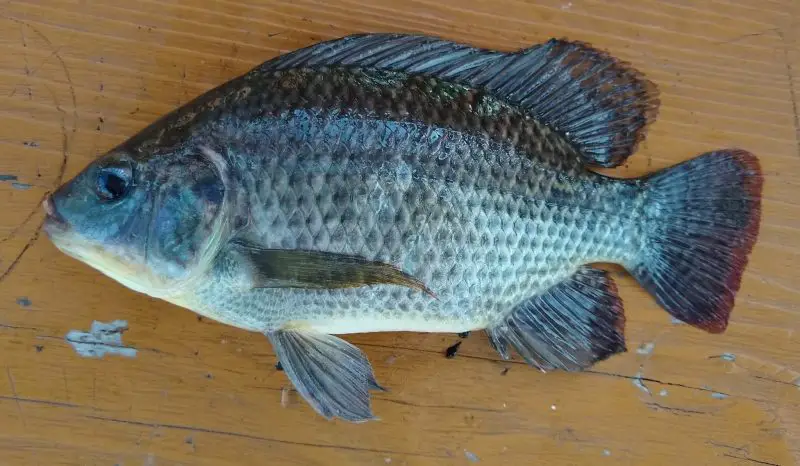
The blue tilapia is a robust, invasive fish originally from Africa and the Middle East, now widespread in Florida’s freshwater environments. It can grow up to 20 inches and is named for its blue-gray coloration, especially visible on the males. Their bodies are deep and laterally compressed with long dorsal fins.
Blue tilapia are recognized by their spiny dorsal fin, forked tail, and the distinctive blue tint on their scales and fins. They are mouthbrooders, with males carrying fertilized eggs in their mouths until the young hatch. This reproductive strategy helps them rapidly colonize new habitats.
In Florida, blue tilapia occupy lakes, canals, and rivers, often in warm waters with moderate vegetation. Their herbivorous diet mainly consists of algae and aquatic plants, which can lead to significant habitat alteration. The species’ aggressive competition with native fish and environmental impact classify it as invasive and a management concern.
Clown Knifefish (Chitala ornata)

The clown knifefish is a large, elongated, and laterally compressed fish native to Southeast Asia but invasive in Florida waters. It can reach lengths over 3 feet, making it one of the larger invasive species. The fish’s body is silvery-gray with dark spots and an unusual, undulating fin that runs along the underside from mid-body to the tail.
Its unique fin shape and spotted body make the clown knifefish easily recognizable. The fish swims by waving its long anal fin in a graceful, wave-like motion. It has a small head with a large mouth full of sharp teeth, adapted to capturing prey in low-light or murky water.
Clown knifefish inhabit canals, ponds, and slow-moving rivers in southern Florida, where they prey on fish, insects, and crustaceans. Their large size, predatory nature, and ability to thrive in various conditions threaten native fish communities. This species is considered invasive due to its potential to disrupt aquatic ecosystems and outcompete native predators.
Midas Cichlid (Amphilophus citrinellus)

The midas cichlid is a large, aggressive fish native to Central America but now invasive in Florida. It commonly reaches 10 to 15 inches in length, with a robust body and a characteristic rounded forehead in adults. The coloration varies from yellow-orange to white, often with darker blotches or spots.
This species is easily identified by its thick lips, large eyes, and strong jaws. Its body shape is oval and laterally compressed, with long dorsal and anal fins. Midas cichlids are territorial and aggressive, especially during breeding, which allows them to dominate habitats and exclude native species.
In Florida, midas cichlids inhabit freshwater lakes, canals, and ponds, mainly in southern parts of the state. Their diet is omnivorous and includes fish, invertebrates, and plant matter. Their aggressive behavior, rapid reproduction, and environmental adaptability make them a threat to native fish populations and local biodiversity.
Spotted Tilapia (Pelmatolapia mariae)

The spotted tilapia is a robust, invasive fish species native to West Africa but introduced to Florida’s waterways. It can grow up to 18 inches long and is known for its dark, vertical spots and bars on a light gray or olive body. Its deep, laterally compressed body and long dorsal fin give it a distinct appearance.
Spotted tilapia are identified by their mottled pattern of spots and bands, broad head, and rounded tail fin. Both males and females build nests and guard their young aggressively. This species is a prolific breeder, which allows it to establish large populations quickly in non-native habitats.
In Florida, spotted tilapia are found in lakes, canals, and slow-moving rivers where they consume algae, aquatic plants, and small invertebrates. Their feeding habits often lead to changes in vegetation and water quality, impacting native species. Due to their invasive nature, spotted tilapia are closely monitored by wildlife agencies.
Saltwater Fish in Florida
Atlantic Sailfish (Istiophorus albicans)
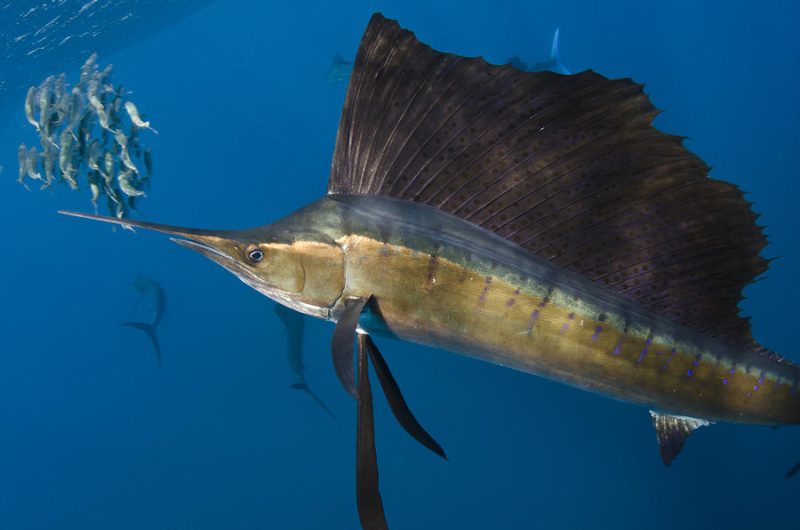
The Atlantic sailfish is one of the fastest and most iconic fish species in Florida’s offshore waters. It is easily recognizable by its long, slender body and an enormous, sail-like dorsal fin that runs almost the entire length of its back. Typically, Atlantic sailfish measure between 5 to 11 feet and can weigh up to 220 pounds. Their color ranges from dark blue on top to silvery white below, with vertical blue bars on the sides.
Identification of the sailfish is straightforward due to its elongated bill and the distinctive sail fin, which it often raises when excited or threatened. This species has a pointed snout and a streamlined shape optimized for speed and agility, allowing it to reach bursts of up to 68 miles per hour. The sail is used for display and to herd schools of smaller fish during hunting.
In Florida, Atlantic sailfish are found mainly in warm, offshore waters of the Atlantic Ocean, particularly around reefs and deep channels. They are highly migratory and often follow the movements of baitfish. Sailfish are aggressive predators, feeding primarily on smaller fish and squid, and are prized targets for sport fishing due to their speed and acrobatics.
Blue Marlin (Makaira nigricans)

The Blue marlin is a large, powerful game fish inhabiting the deep offshore waters around Florida. Known for their impressive size, blue marlins can grow up to 14 feet long and weigh more than 1,000 pounds, making them one of the largest billfish species. Their bodies are robust with a cobalt blue back, silvery sides, and a distinctive pointed bill.
The blue marlin is identified by its tall, rigid dorsal fin and a sharp, spear-like upper jaw that can be longer than its body depth. Their streamlined bodies and muscular build make them extraordinary swimmers capable of long-distance migrations. The color of their bodies can change slightly, often displaying vertical stripes when hunting or excited.
Blue marlins are typically found in the Gulf Stream off the coast of Florida and other tropical and subtropical Atlantic waters. They prefer warm, deep waters and are apex predators, feeding on tuna, mackerel, squid, and other large fish. Their powerful leaps and fighting ability make them highly sought after by anglers worldwide.
White Marlin (Kajikia albida)

The white marlin is a smaller and more slender billfish species than the blue marlin, common in Florida’s Atlantic waters. Adults usually range between 5 to 7 feet in length and weigh up to 180 pounds. Their coloration is more silvery with a white or pale blue belly and a darker blue or gray back, which provides camouflage in the open ocean.
White marlins are recognized by their relatively shorter bill compared to other marlins and a dorsal fin that is lower and more rounded. They have a streamlined body designed for speed, helping them pursue fast-moving prey. Unlike blue marlins, white marlins tend to have a more subtle vertical stripe pattern on their sides.
This species inhabits warm offshore waters, especially in the Gulf Stream and surrounding the Florida Keys. White marlins are highly migratory and often feed on small schooling fish such as sardines and squid. They are prized in sport fishing for their challenging fight and quick, acrobatic jumps.
Mahi-Mahi (Dolphinfish) (Coryphaena hippurus)
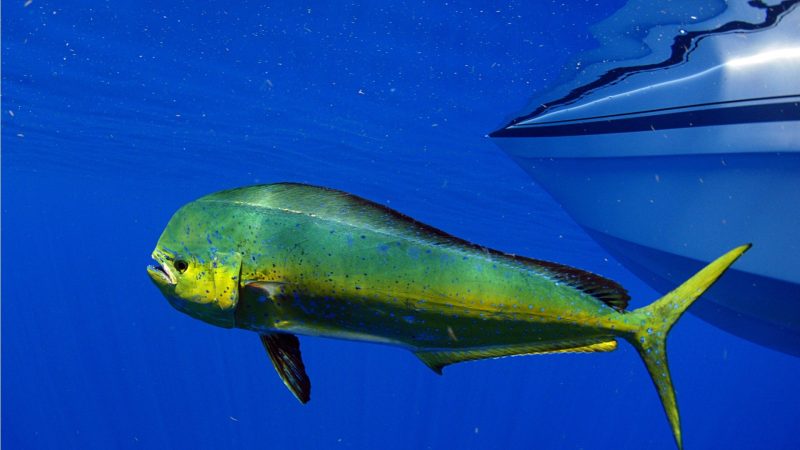
The mahi-mahi, also known as dolphinfish, is a vibrant and fast-growing pelagic fish common in Florida’s warm coastal waters. It is famous for its striking colors, which include bright blues, greens, and yellows. Mahi-mahi typically grow up to 3 to 4 feet in length and can weigh around 15 to 30 pounds, though larger specimens exist.
Identification is easy due to their blunt heads, long dorsal fins that extend nearly the length of the body, and brilliant coloration that often fades rapidly after death. Males (bulls) have a more pronounced forehead, while females (cows) have a slightly rounded head. Mahi-mahi are known for their agility and speed in the water.
Mahi-mahi inhabit surface waters along Florida’s Atlantic coast and Gulf of Mexico, often around floating debris or seaweed where they find food. Their diet mainly consists of flying fish, squid, and crustaceans. They are popular with commercial and recreational fisheries due to their delicious taste and sport fighting ability.
King Mackerel (Scomberomorus cavalla)
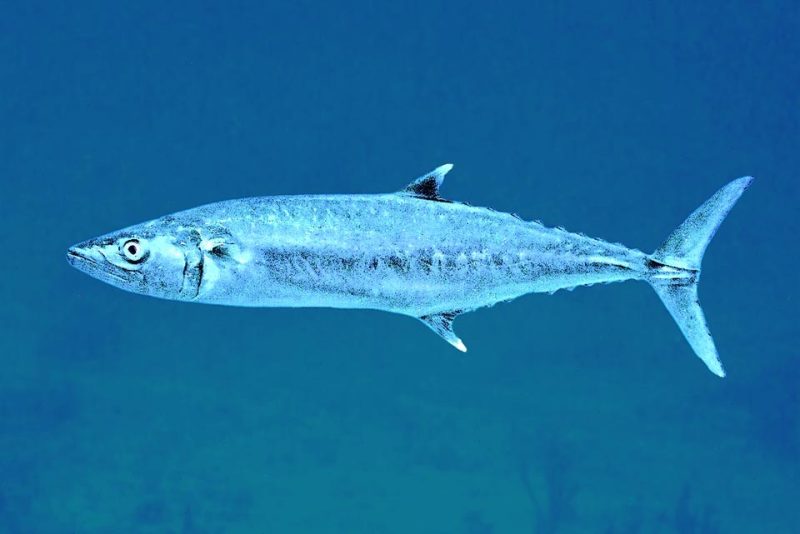
The king mackerel is a fast, predatory fish commonly found in Florida’s coastal and offshore waters. It has a slender, streamlined body with a sharply pointed head and forked tail, typically growing to lengths of 3 to 5 feet and weighing up to 40 pounds or more. The body is silver with faint spots along the sides.
King mackerel can be identified by their long, narrow bodies and sharp teeth, suited for their carnivorous diet. They have two dorsal fins, with the first being spiny and the second soft-rayed. Their scales are small and smooth, giving them a sleek appearance that helps in fast swimming.
In Florida, king mackerel frequent coastal reefs, wrecks, and open waters, especially during warmer months. They are aggressive hunters, preying on smaller fish such as sardines, menhaden, and other schooling species. They are a favorite target for anglers due to their speed, strength, and tasty flesh.
Spanish Mackerel (Scomberomorus maculatus)

The Spanish mackerel is a fast, slender fish commonly found in Florida’s coastal waters. It has a streamlined body with a greenish-blue back and silvery sides marked with numerous yellow or gold spots. Typically, Spanish mackerel grow to around 2 feet in length but can occasionally reach up to 3 feet.
Identification is straightforward due to their bright spots and sharp teeth, which are well-adapted for hunting small fish and crustaceans. They have two dorsal fins and a deeply forked tail that helps them achieve swift bursts of speed, making them effective predators in the nearshore environment.
In Florida, Spanish mackerel inhabit warm waters along the Atlantic coast and the Gulf of Mexico, often near reefs, estuaries, and shorelines. They are migratory, moving closer to shore during warmer months to feed on schools of baitfish. Their aggressive feeding behavior makes them popular among sport fishermen.
Cobia (Rachycentron canadum)
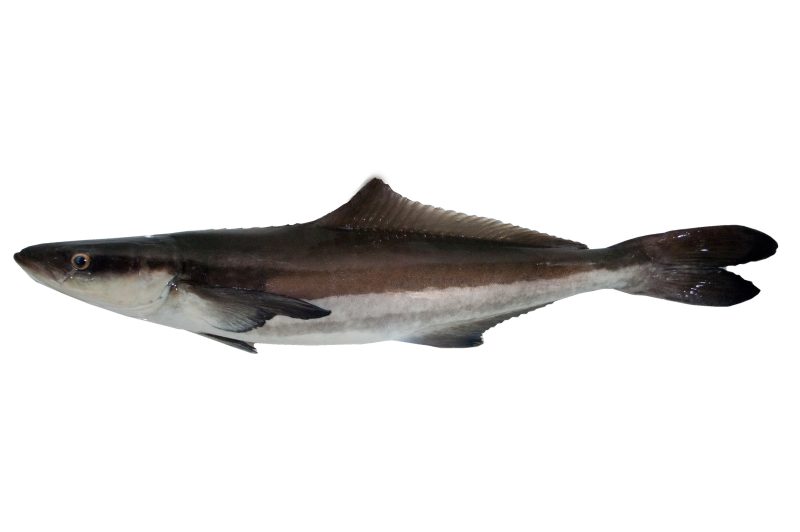
The cobia is a large, muscular fish commonly found in Florida’s warm coastal and offshore waters. It has an elongated body with a broad, flat head and a dark brown to gray coloration with faint horizontal stripes on its sides. Cobia can grow up to 6 feet in length and weigh over 100 pounds.
Cobia are identified by their long, slender shape and two dorsal fins, the first being low and long. Their broad head and large mouth help distinguish them from other coastal fish species. Juveniles often have vertical bars that fade as they mature.
In Florida, cobia are found near reefs, wrecks, buoys, and around structures such as oil rigs. They are opportunistic predators feeding on crabs, squid, and smaller fish. Cobia are prized in recreational fishing for their strong fight and excellent eating qualities.
Wahoo (Acanthocybium solandri)

The wahoo is a sleek, fast-swimming predator inhabiting offshore waters of Florida. It has a long, torpedo-shaped body with striking vertical blue stripes over a silver background. Wahoos can reach lengths up to 7 feet and weigh more than 100 pounds.
Identification of the wahoo is notable due to its sharp, razor-like teeth and slender body built for speed. It has a pointed snout and a high dorsal fin that extends along much of its back. Wahoo is one of the fastest fish in the ocean, capable of incredible bursts of speed.
Wahoo prefer open ocean environments and are often found near deep drop-offs or floating debris. They feed aggressively on smaller schooling fish such as mackerel, sardines, and squid. Wahoo are highly sought after for sport fishing because of their speed and delicious flesh.
Tuna (Yellowfin, Blackfin, Bluefin)
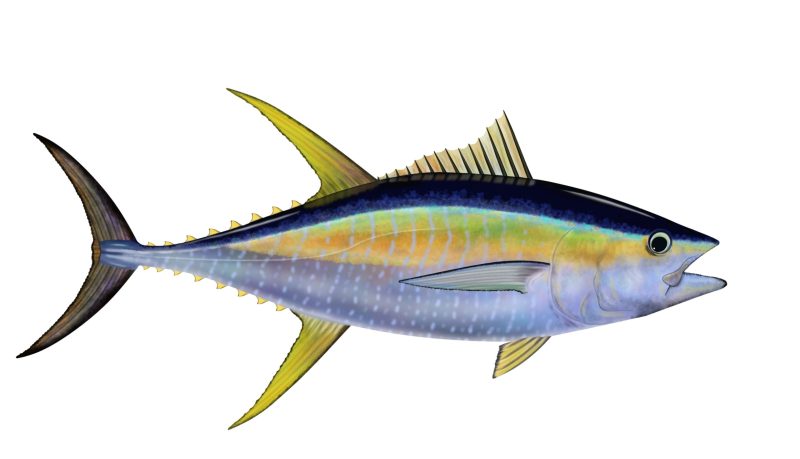
Tuna are powerful, streamlined fish species widely distributed in Florida’s offshore waters. The Yellowfin tuna is the most common, characterized by bright yellow fins and a metallic dark blue back. Blackfin tuna are smaller with a black dorsal fin, while Bluefin tuna are the largest and prized for their size and strength.
Identification varies by species but generally includes a robust, torpedo-shaped body designed for fast swimming. Tuna have strong, muscular bodies with small fins and a distinctive crescent-shaped tail, enabling long-distance migrations and fast sprints.
In Florida, tuna species inhabit warm, deep waters, often near the Gulf Stream or around floating objects where baitfish gather. They are carnivorous, feeding on squid, smaller fish, and crustaceans. Tuna are highly valued by commercial and sport fisheries for their meat and fighting ability.
Barracuda (Sphyraena barracuda)

Barracudas are aggressive predatory fish common in Florida’s coastal and reef waters. They have elongated, cylindrical bodies with pointed heads and large jaws filled with sharp, fang-like teeth. Barracudas typically grow between 2 to 4 feet but can reach lengths over 6 feet.
Barracudas are easily identified by their silver coloration with dark bars or spots along their sides. Their powerful jaws and sharp teeth are designed for seizing prey quickly. They have a sleek body shape optimized for sudden bursts of speed to ambush prey.
In Florida, barracudas are found near reefs, wrecks, and seagrass beds where they hunt smaller fish such as grunts and mullets. Known for their aggressive behavior and swift attacks, barracudas are popular among sport fishers but can pose a danger due to their sharp teeth and sometimes unpredictable nature.
Amberjack (Seriola dumerili)
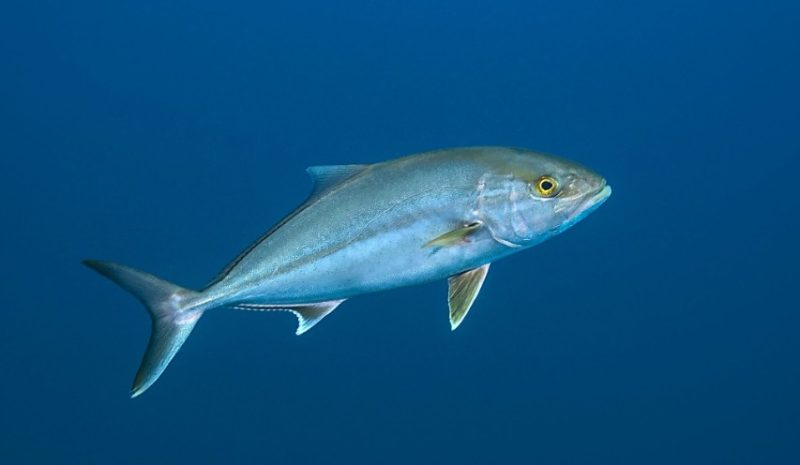
The amberjack is a large, powerful fish commonly found in Florida’s offshore waters. It has an elongated, robust body with a distinctive amber or brownish stripe running from its nose through the eye to the tail. Amberjacks can grow up to 6 feet long and weigh over 100 pounds, making them one of the top predators on reefs and wrecks.
Identification includes a blunt head, strong tail, and two dorsal fins, with the first being spiny and the second soft-rayed. Their coloration is typically silver-gray with darker backs and lighter undersides, helping them blend into open water environments. Juveniles have a similar appearance but are smaller and slimmer.
In Florida, amberjacks inhabit deep reefs, shipwrecks, and rocky outcrops primarily in the Gulf of Mexico and Atlantic Ocean. They are aggressive hunters feeding on smaller fish, squid, and crustaceans. Amberjacks are popular among sport fishermen due to their fighting strength and size.
Crevalle Jack (Caranx hippos)
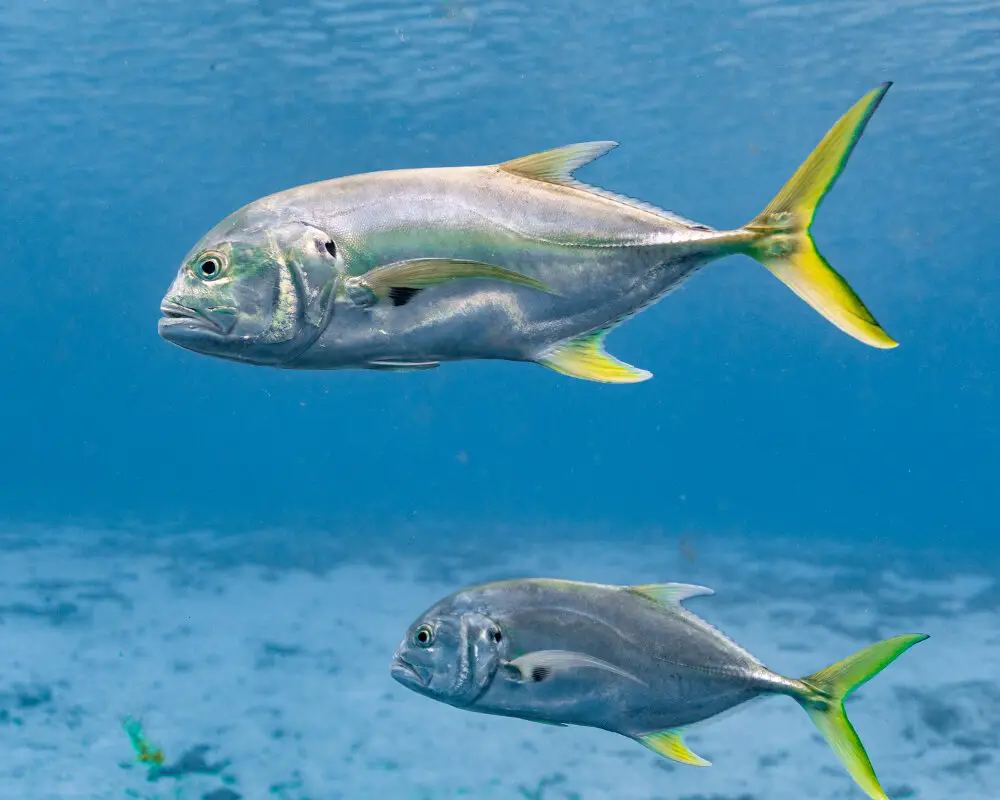
The crevalle jack is a common coastal species in Florida’s waters, easily recognizable by its deep, compressed body and prominent black spot on the gill cover. It has a silver body with a yellowish or greenish tint on the back, growing up to 3 feet in length and weighing around 20 pounds.
Identification includes a forked tail, strong jaws, and sharp teeth. They have two dorsal fins, the first with spines and the second soft-rayed, and a dark spot near the pectoral fins. Their powerful, streamlined body enables fast swimming to chase prey.
Crevalle jacks are found in bays, estuaries, and nearshore waters around Florida, often schooling near bridges and jetties. They feed on smaller fish and crustaceans and are known for their aggressive feeding behavior. They are popular with anglers for their strength and spirited fight.
Blue Runner (Caranx crysos)
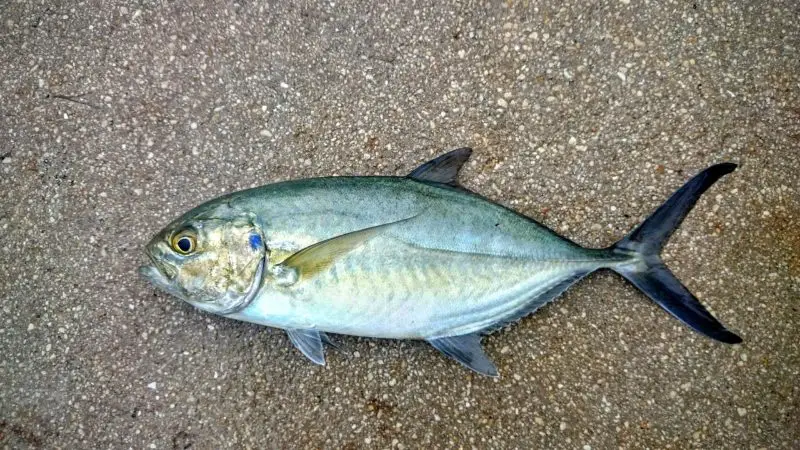
The blue runner is a medium-sized schooling fish common in Florida’s coastal and offshore waters. It has a slender, streamlined body with bright blue-green coloration on its back and silver sides. Blue runners typically grow up to 2 feet long.
They are identified by their forked tail, strong dorsal fins, and deeply forked caudal fin. Their scales are small and smooth, and they have a slightly pointed snout. The blue runner often swims in large schools, especially near reefs and rocky bottoms.
In Florida, blue runners are abundant nearshore and offshore, especially around reefs, wrecks, and pilings. They feed mainly on smaller fish and invertebrates. While not a primary game fish, blue runners are important forage species for larger predatory fish.
Snook (Centropomus undecimalis)

Snook is a popular sport fish native to Florida’s coastal waters and estuaries. It has a sleek, elongated body with a prominent black lateral line running from the gills to the tail. Snook are usually silver with a slightly greenish tint and can reach lengths over 4 feet and weigh more than 40 pounds.
Identification includes a large mouth with a protruding lower jaw and two dorsal fins, the first with spines and the second soft. Their powerful tail fin helps them make quick bursts of speed to ambush prey.
Snook are found mainly in brackish and saltwater environments along Florida’s coast, including mangroves, estuaries, and bays. They feed on shrimp, crabs, and smaller fish. Due to their challenging fight and tasty flesh, snook are highly prized by recreational anglers.
Tarpon (Megalops atlanticus)
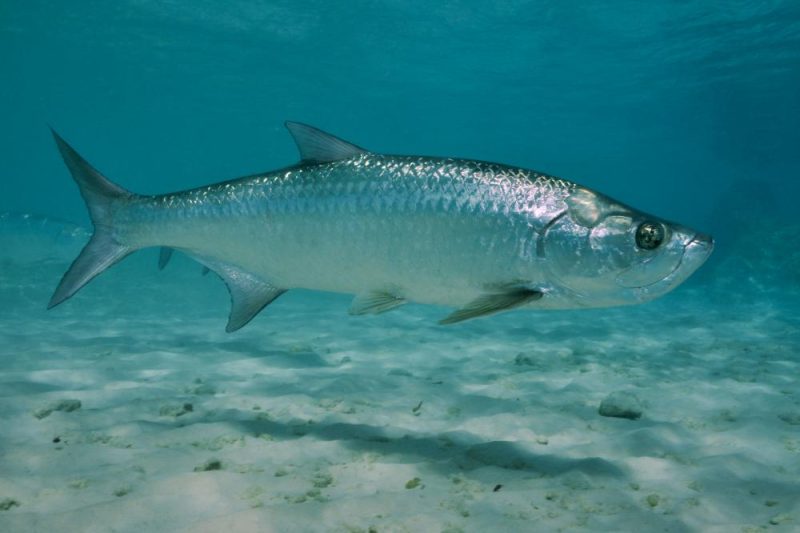
Tarpon is a legendary game fish found in Florida’s warm coastal waters and estuaries. They have a large, elongated body covered with shiny, silver scales and can grow up to 8 feet long and weigh over 200 pounds. Their large, upturned mouth and elongated dorsal fin are distinctive features.
Identification includes a prominent, bony dorsal fin with long spines and a large mouth capable of gulping air due to their ability to breathe atmospheric oxygen. Tarpons are known for spectacular leaps when hooked, earning them the nickname “Silver King.”
In Florida, tarpons are common in estuaries, bays, and nearshore waters, often near mangroves and oyster beds. They feed primarily on smaller fish and crustaceans. Tarpons are celebrated for their acrobatic fighting ability, making them a favorite among sport fishermen worldwide.
Red Drum (Sciaenops ocellatus)
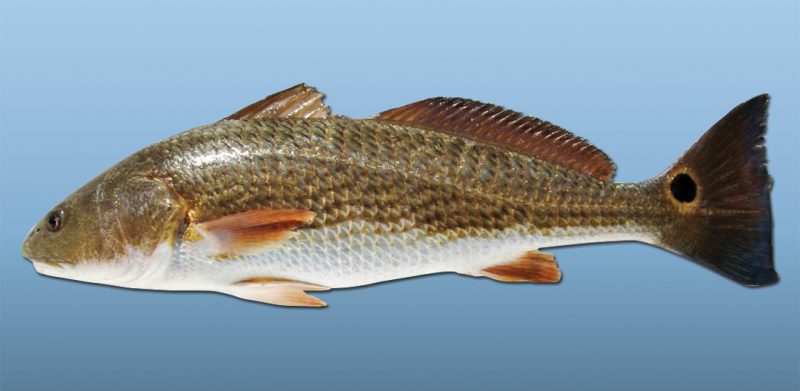
The red drum, also known as redfish, is a popular saltwater game fish found throughout Florida’s coastal waters. It has a copper-bronze body that fades to a lighter belly and is best known for one or more distinctive black spots near the tail. Red drum can grow up to 4 feet long and weigh more than 30 pounds.
Identification includes its elongated body, a slightly arched back, and a rounded tail fin. The color varies by age and environment but usually includes reddish-bronze shades with silvery sides. Juveniles tend to have more pronounced spots, sometimes with multiple spots along the tail base.
In Florida, red drum inhabit estuaries, bays, and nearshore waters with sandy or muddy bottoms. They are bottom feeders, consuming crabs, shrimp, and small fish. Red drum are highly valued by anglers for their strong fight and are a symbol of Florida’s sportfishing heritage.
Black Drum (Pogonias cromis)
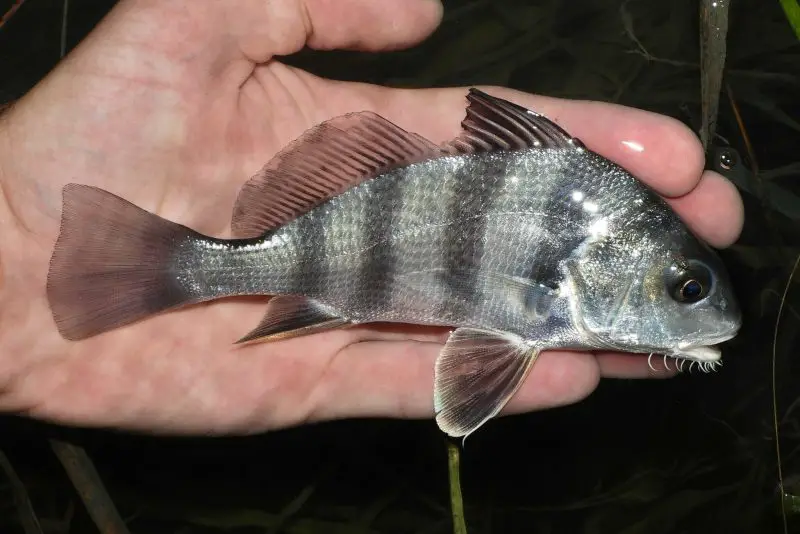
Black drum are large, robust fish commonly found in Florida’s bays and estuaries. They have a dark gray to black coloration, especially on the back, which fades to lighter sides and belly. Adults often develop a high, arched back and can reach lengths of up to 5 feet and weights exceeding 90 pounds.
Identification features include a broad, rounded head with barbels (whisker-like sensory organs) on the lower jaw used to detect food. The black drum has thick lips and a broad tail fin. Juveniles may display vertical bars or stripes which fade as they mature.
In Florida, black drum prefer shallow waters with sandy or muddy bottoms where they feed mainly on mollusks, crustaceans, and small fish. They are slow but powerful fighters, and their tough mouths are adapted for crushing shellfish. Black drum are popular among both commercial and recreational fishermen.
Spotted Seatrout (Cynoscion nebulosus)
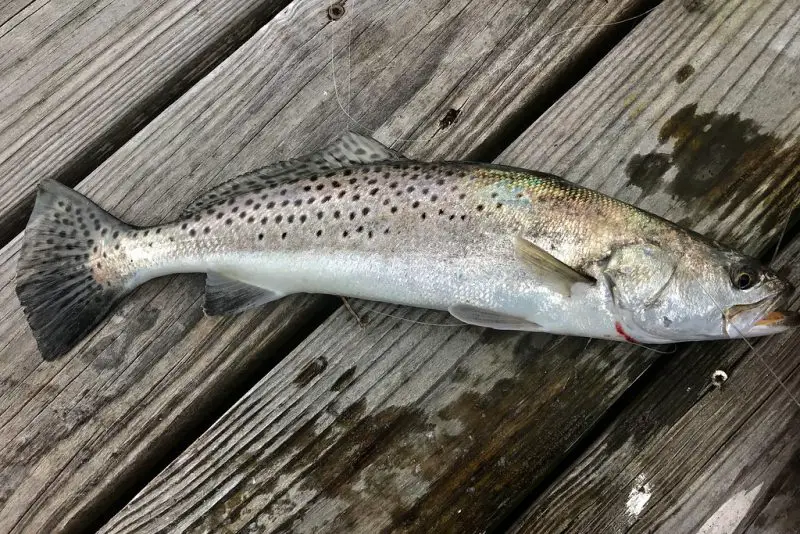
Spotted seatrout, also called speckled trout, is a common coastal fish in Florida, especially in shallow bays and estuaries. It has an elongated, slender body with a silvery color and numerous black spots scattered over the back and tail. These fish typically grow to about 2 feet in length.
Identification is aided by the spotted pattern along the body and a large mouth with canine-like teeth. The dorsal fin is divided into two parts, with the front section having sharp spines. The body is streamlined for quick bursts of speed.
Spotted seatrout inhabit grassy flats, oyster beds, and shallow coastal waters in Florida. Their diet consists mainly of shrimp, small fish, and crustaceans. They are popular with anglers due to their abundance, ease of catch, and tasty flesh.
Weakfish (Cynoscion regalis)

Weakfish are slender, silvery fish with a slight green or brownish tint on their backs, commonly found in Florida’s coastal and estuarine waters. They typically reach lengths of 2 to 3 feet and have a streamlined shape suited for fast swimming.
Identification features include a large mouth with sharp teeth and scattered black spots along the upper body and dorsal fin. The dorsal fin is long and separated into two parts. Weakfish have a softer body texture compared to other members of the drum family, hence the name “weakfish.”
In Florida, weakfish are usually found in shallow bays, estuaries, and nearshore waters. They feed on small fish, shrimp, and crustaceans. Weakfish are popular among recreational anglers for their fighting ability and are often targeted during their seasonal migrations.
Pompano (Trachinotus carolinus)
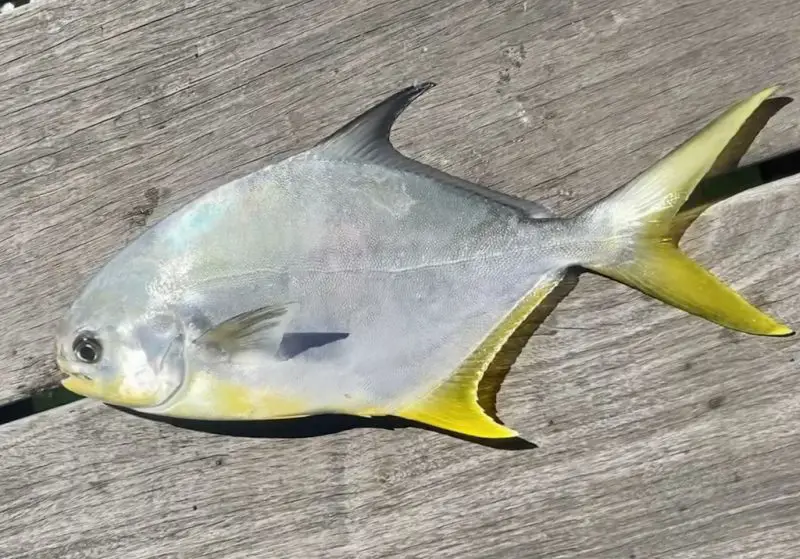
Pompano is a prized game fish found in Florida’s warm coastal waters and surf zones. It has a deep, compressed body with a silver sheen and faint yellowish hues near the fins. Pompano typically grow to about 1.5 feet long but can occasionally reach up to 2 feet.
Identification includes a rounded body shape, a small mouth, and forked tail. Their smooth, sleek body with subtle yellow highlights makes them easy to distinguish from other coastal species. Pompano are known for their fast swimming and agility.
In Florida, pompano are found near sandy beaches, surf zones, and estuaries where they feed primarily on crustaceans, mollusks, and small fish. They are highly regarded for their delicate, flavorful flesh and are a favorite target for both commercial and recreational fisheries.
Permit (Trachinotus falcatus)
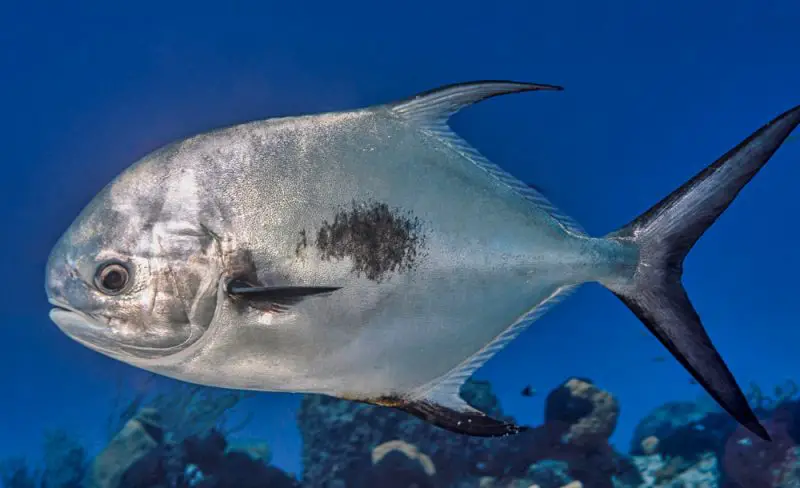
Permit is a highly prized game fish in Florida, known for its speed and challenging fight. It has a deep, laterally compressed body with a silvery color and subtle bronze or olive hues on the back. Permit often reach lengths of 3 to 4 feet and can weigh over 40 pounds.
Identification features include a small head, blunt nose, and a distinctive black patch near the pectoral fins. Their dorsal and anal fins are long and sickle-shaped, giving them a graceful appearance when swimming. The tail fin is deeply forked to aid in quick bursts of speed.
In Florida, permits are commonly found in shallow sandy flats, near coral reefs, and wrecks along the Atlantic coast and the Florida Keys. Their diet consists mainly of crabs, shrimp, and small fish. Due to their elusive nature and strong fighting ability, permits are among the most sought-after sport fish in the region.
Sheepshead (Archosargus probatocephalus)

Sheepshead is a coastal fish recognizable by its distinctive black and white vertical stripes resembling a zebra pattern. It has a deep, compressed body with strong teeth that resemble human molars, used for crushing shells. Sheepshead typically grow up to 2 feet long and weigh around 10 pounds.
Identification includes a small, blunt head, a rounded snout, and a sharp dorsal fin with spines. Their striped coloration helps camouflage them among pilings, rocks, and oyster beds. Their teeth are uniquely adapted for crushing crustaceans and mollusks.
In Florida, sheepshead are commonly found in coastal waters, especially around bridges, piers, and rocky bottoms. They feed primarily on barnacles, crabs, shrimp, and bivalves. Sheepshead are popular with anglers due to their tough fight and delicious white meat.
Flounder (Southern, Gulf, Summer)

Flounder are flatfish species found in Florida’s coastal waters, including the Southern, Gulf, and Summer flounder varieties. They have a flattened body with both eyes on one side, allowing them to lie flat on the ocean floor. Flounder typically grow up to 2 feet long and are well camouflaged with mottled brown and gray coloring.
Identification features include a broad, oval-shaped body and a mouth positioned on the underside. Their ability to change color and blend with the sandy or muddy bottom provides excellent camouflage from predators and prey alike. Flounder use their eyes on the upper side to watch for food.
In Florida, flounder inhabit shallow coastal waters, estuaries, and bays. They are ambush predators feeding mainly on small fish, shrimp, and crabs. Flounder are prized for their mild, delicate-flavored white flesh and are a favorite target for both recreational and commercial fishing.
Hogfish (Lachnolaimus maximus)
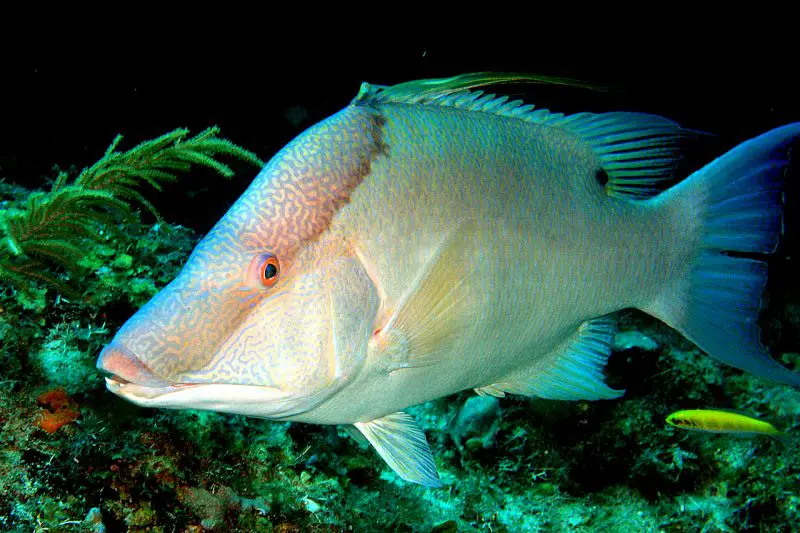
Hogfish is a colorful reef fish found primarily around Florida’s coral reefs and rocky bottoms. It has an elongated body with a distinctive pig-like snout used to root around the seabed for prey. Hogfish usually reach lengths of 2 feet and weigh up to 15 pounds.
Identification is notable for the long, pointed dorsal fin spine and the fish’s ability to change color, ranging from reddish to pale pink or brown. The pig-like snout is an adaptation for digging in the sand and extracting crustaceans and mollusks.
In Florida, hogfish inhabit shallow reefs and rocky areas in the Gulf of Mexico and Atlantic waters near the Keys. They feed on crustaceans, mollusks, and small fish. Hogfish are highly valued for their firm, sweet-tasting flesh and are popular among spearfishers and recreational anglers.
Red Snapper (Lutjanus campechanus)
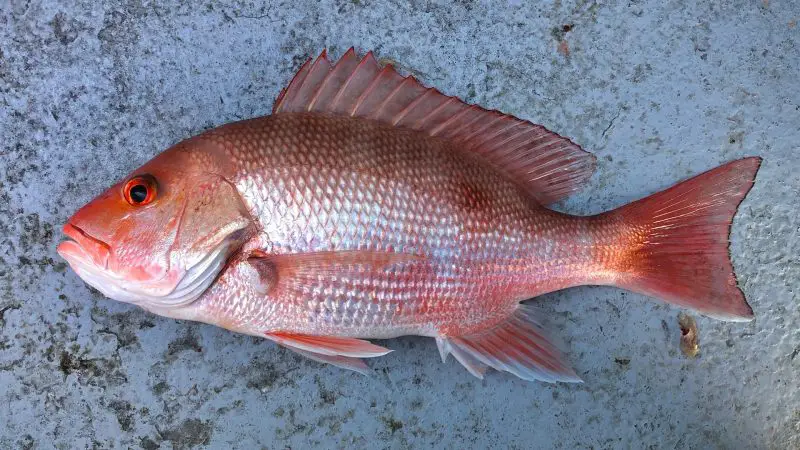
Red snapper is one of Florida’s most iconic and sought-after game fish. It has a bright red to pinkish body with a streamlined, oval shape and sharp dorsal spines. These fish can grow to over 3 feet in length and weigh up to 50 pounds or more.
Identification includes a pointed snout, large eyes, and a continuous dorsal fin with spiny and soft rays. Their bright coloration helps them stand out among reef structures. Juveniles have a similar appearance but are smaller and more vulnerable to predators.
Red snapper inhabit deep reefs, ledges, and wrecks along Florida’s Atlantic coast and Gulf of Mexico. They feed on smaller fish, shrimp, and squid. Known for their excellent taste and firm texture, red snapper are a prized catch for commercial and recreational fishermen alike.
Mangrove Snapper (Lutjanus griseus)
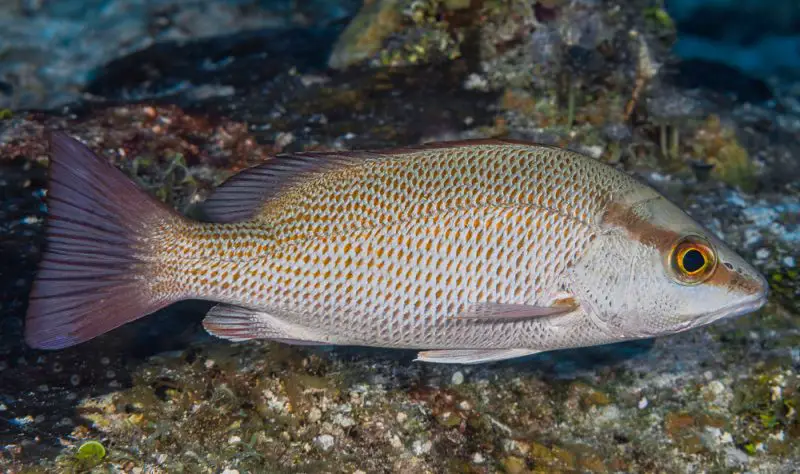
Mangrove snapper, also known as gray snapper, is a common coastal fish in Florida with a robust, medium-sized body typically reaching up to 2 feet in length. Its coloration ranges from gray to reddish-brown with faint vertical bars on the sides and a dark spot on the upper side near the gill cover.
Identification includes a large mouth with sharp teeth, slightly forked tail, and a rounded dorsal fin with spines. Mangrove snappers have a stout body and are known for their adaptability to various habitats, from mangroves and estuaries to reefs and wrecks.
In Florida, mangrove snapper inhabit shallow coastal waters, mangrove-lined shorelines, and reefs. They feed primarily on fish, crustaceans, and mollusks. Popular among anglers, they are prized for their tasty, firm white meat and their aggressive fight.
Yellowtail Snapper (Ocyurus chrysurus)

Yellowtail snapper is a brightly colored fish easily recognized by its yellow stripe running from the snout to the tail and its vibrant yellow forked tail. It has a slender, streamlined body that typically grows up to 2 feet in length.
Identification features include a silvery body with greenish hues, bright yellow fins, and a distinct yellow stripe. This species has a small mouth and sharp teeth suited for its diet of small fish and invertebrates.
In Florida, yellowtail snapper are commonly found around coral reefs and rocky ledges, especially in the Florida Keys. They are fast swimmers and feed mainly on small fish, shrimp, and crabs. Valued for their sweet, mild flesh, they are a favorite target for both recreational and commercial fishing.
Mutton Snapper (Lutjanus analis)

Mutton snapper is a large, colorful snapper species found in Florida’s offshore reefs and deeper waters. It has an olive-green to reddish body with a pinkish hue and several dark vertical bars on the sides. Adults can reach lengths of over 3 feet and weigh up to 30 pounds.
Identification includes a rounded profile, a large mouth, and a pointed snout. The dorsal fin is continuous with both spiny and soft rays, and the tail is slightly forked. Juveniles often display a distinctive black spot on the dorsal fin base.
Mutton snapper inhabit coral reefs and rocky ledges, feeding on fish, shrimp, and crabs. They are prized by anglers for their strong fight and delicious, flaky white meat. This species is an important part of Florida’s reef fishery.
Lane Snapper (Lutjanus synagris)
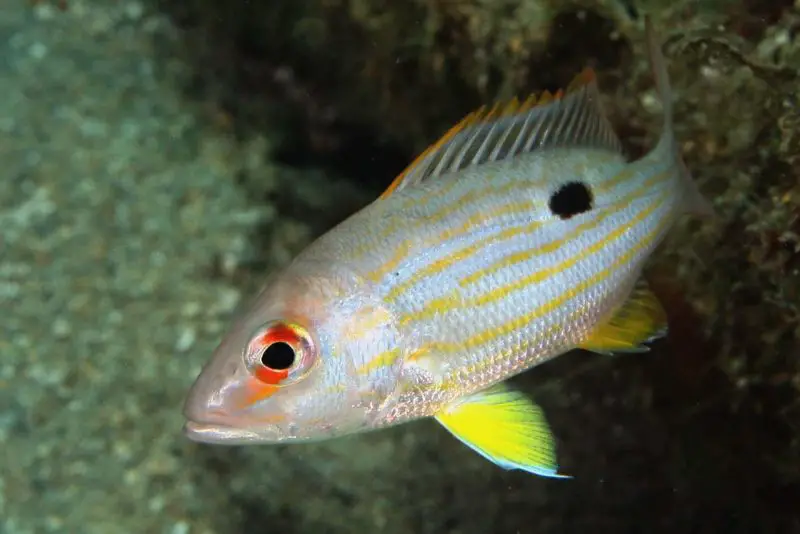
Lane snapper is a medium-sized snapper species with a slender body, usually growing up to about 1.5 feet long. Its coloration includes pinkish or reddish tones with numerous yellow or gold horizontal stripes along the sides, which help with identification.
The lane snapper has a pointed snout and a large mouth with sharp teeth. Its dorsal fin is continuous, and the tail is forked. A distinctive black spot is often present on the side just below the dorsal fin.
In Florida, lane snapper are found on sandy bottoms, reefs, and grassy flats in both shallow and moderate depths. Their diet consists of small fish, crustaceans, and mollusks. Lane snapper are popular for their delicate flavor and are targeted by both recreational and commercial fisheries.
Cubera Snapper (Lutjanus cyanopterus)
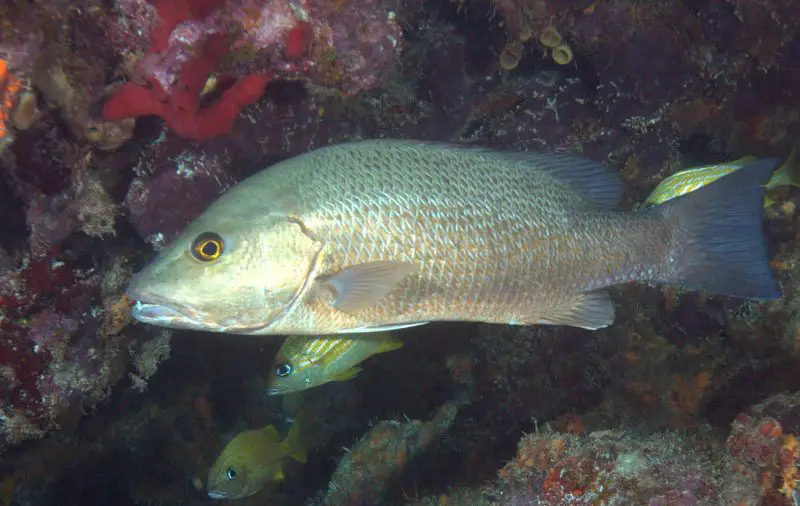
Cubera snapper is the largest snapper species in Florida, capable of growing over 4 feet long and weighing up to 100 pounds or more. It has a robust, deep body with a dark reddish to brownish color and large canine teeth used for capturing prey.
Identification features include a blunt snout, large eyes, and powerful jaws with prominent canine teeth. The body is usually uniformly colored with no distinct stripes or spots, making it distinguishable from other snappers.
In Florida, cubera snapper inhabit deep reefs, wrecks, and rocky bottoms along the Atlantic coast and Gulf of Mexico. They are apex predators feeding on large fish, crustaceans, and squid. Their size and strength make them a prized but challenging target for experienced anglers.
Gag Grouper (Mycteroperca microlepis)
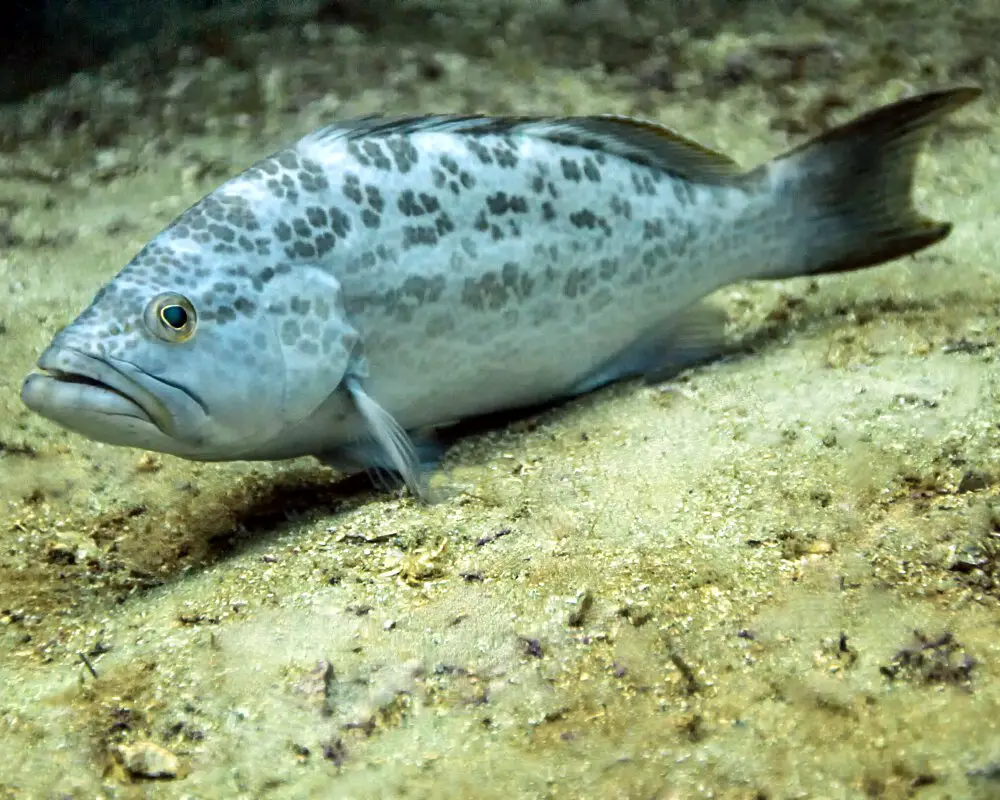
Gag grouper is a popular and abundant species in Florida’s coastal waters, recognized for its gray to brownish body with faint, irregular blotches and spots. They typically grow up to 3 feet in length but can reach over 4 feet, weighing around 50 pounds.
Identification features include a broad, elongated body with a large mouth and strong jaws. Gag groupers have a rounded tail and small dark spots on the head and body, which become more prominent as they age. Juveniles often display vertical bars that fade with maturity.
In Florida, gag grouper inhabit rocky reefs, ledges, and wrecks along both the Gulf of Mexico and Atlantic coasts. They are ambush predators feeding on fish, squid, and crustaceans. Gag grouper is highly prized for its firm, white meat and is a favorite among anglers.
Red Grouper (Epinephelus morio)
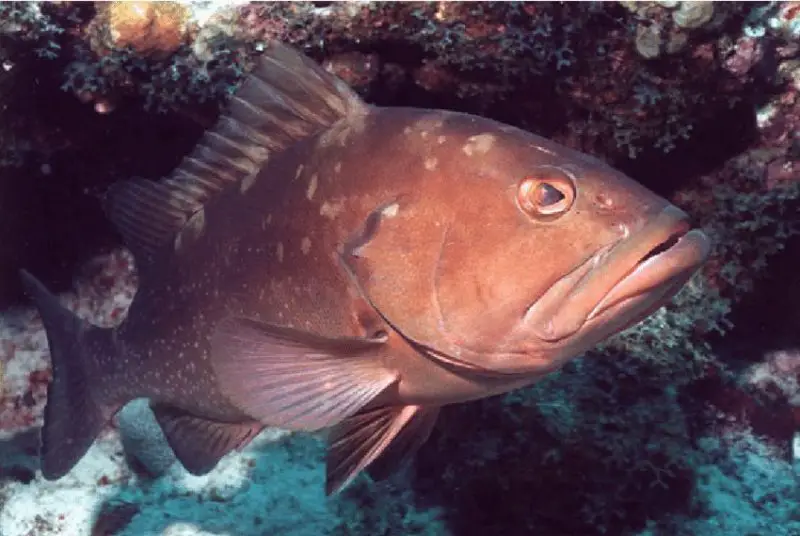
Red grouper is easily identified by its reddish-brown color with darker blotches scattered over the body and fins. They can grow up to 3 feet long and weigh around 40 pounds. This species has a robust, heavy body with a large mouth and strong teeth.
Identification includes a broad, blunt head, rounded tail, and distinctive red to brown coloration. They have small dark spots on the upper body and fins and tend to be more reddish than other groupers.
In Florida, red grouper are commonly found around coral reefs, rocky ledges, and artificial structures on the Gulf of Mexico side. They feed on fish, crabs, and squid. Due to their delicious flavor and firm texture, red grouper are an important commercial and recreational species.
Goliath Grouper (Epinephelus itajara)
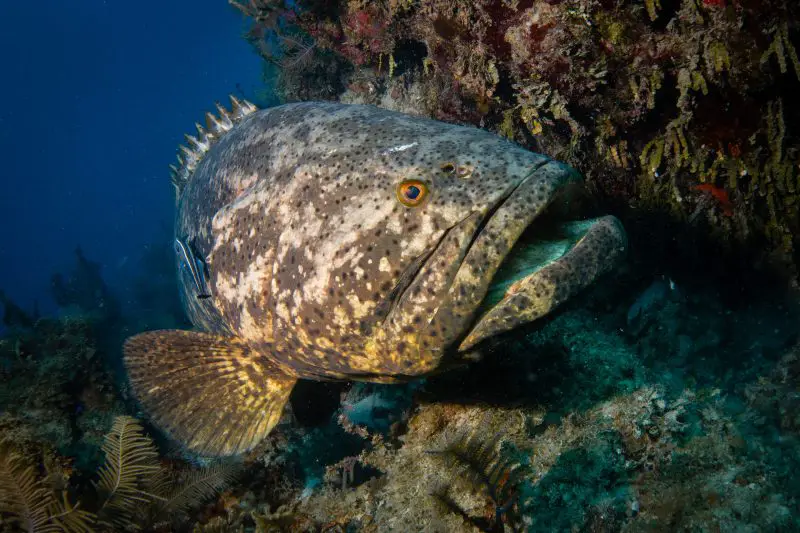
Goliath grouper is the largest grouper species in Florida, capable of growing up to 8 feet long and weighing more than 700 pounds. They have a massive, heavy body with mottled gray to greenish-brown coloring, helping them blend into reef habitats.
Identification includes a broad head, small eyes, and thick lips. Their body is covered with dark blotches and spots, and they have powerful jaws capable of crushing shells and large prey. Juveniles have lighter coloring with more distinct spots.
In Florida, goliath grouper inhabit shallow waters around reefs, wrecks, and mangroves mainly in the Gulf of Mexico and Atlantic coasts. They are slow-moving ambush predators feeding on crustaceans, fish, and even small sharks. Due to their size and strength, they are protected by fishing regulations but remain a favorite sight for divers.
Black Grouper (Mycteroperca bonaci)
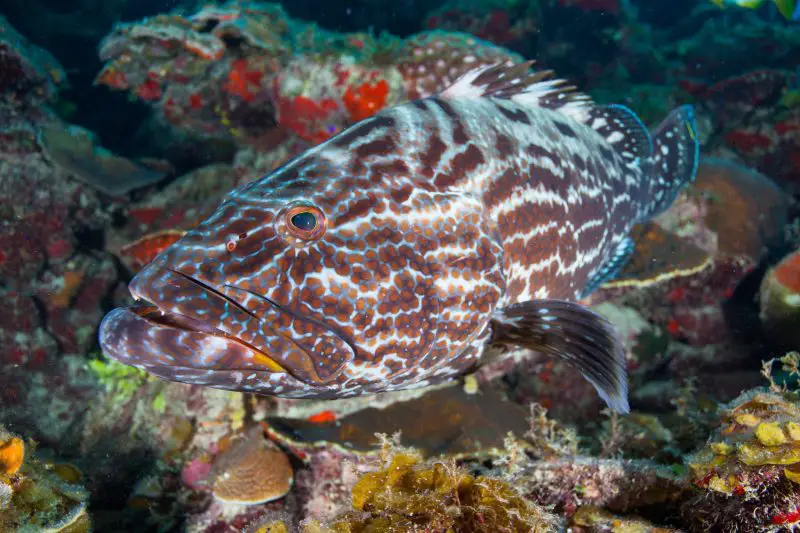
Black grouper is a large predatory fish known for its dark, mottled brown to black coloration, which helps camouflage it among reefs. It can grow over 4 feet long and weigh more than 80 pounds.
Identification features include a large, heavy body with a blunt snout and a broad mouth filled with strong teeth. Their coloration consists of dark blotches and spots that vary in intensity, often with a lighter underside.
In Florida, black grouper inhabit rocky reefs, ledges, and wrecks primarily in the Gulf of Mexico and along the Atlantic coast. They feed on fish, squid, and crustaceans and are known for their ambush hunting tactics. Black grouper is highly sought after for its excellent taste and firm texture.
Nassau Grouper (Epinephelus striatus)
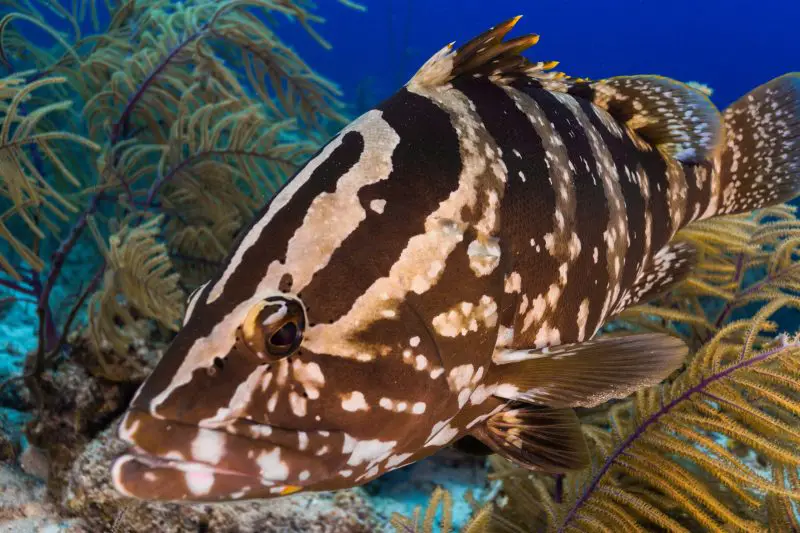
Nassau grouper is a striking species with a pale body covered in dark vertical stripes and blotches, giving it a banded appearance. It typically grows to about 3 feet in length and can weigh up to 30 pounds.
Identification includes a robust body, rounded tail, and large mouth. Their distinctive coloration includes alternating dark and light vertical bars, which help with camouflage among coral reefs.
In Florida, Nassau grouper are found mainly in the Florida Keys and other reef areas in the Caribbean waters. They prefer deep reef habitats and are primarily nocturnal feeders, preying on fish and crustaceans. Nassau grouper populations have declined due to overfishing, leading to conservation efforts and fishing restrictions.
Lionfish (Pterois volitans) – invasive

Lionfish is a strikingly beautiful but highly invasive species in Florida’s waters, originally native to the Indo-Pacific region. It has a distinctive appearance with long, venomous spines radiating from its body, and a pattern of reddish, white, and brown vertical stripes.
Identification includes large pectoral fins that fan out like a mane and venomous dorsal spines used for defense. Lionfish have a deep, laterally compressed body and a mouth capable of rapid suction feeding.
In Florida, lionfish are found throughout coral reefs, wrecks, and rocky substrates in both the Atlantic and Gulf waters. Their invasive nature poses a serious threat to native fish populations as they are voracious predators with few natural predators. Efforts are ongoing to control their population through targeted fishing.
Bonnethead Shark (Sphyrna tiburo)

Bonnethead shark is a small species of hammerhead shark native to Florida’s coastal waters. It gets its name from the distinctive shovel-shaped head, which is more rounded and smaller than other hammerheads. Adults typically grow up to 4 feet in length.
Identification includes the broad, curved “bonnet” shape of the head, two dorsal fins nearly equal in size, and a slender body. They have sharp teeth adapted for crushing crustaceans and mollusks.
In Florida, bonnethead sharks inhabit shallow coastal bays, estuaries, and seagrass beds. They feed mainly on crabs, shrimp, and small fish. Bonnetheads are known for their schooling behavior and are important to the local ecosystem as mid-level predators.
Blacktip Shark (Carcharhinus limbatus)
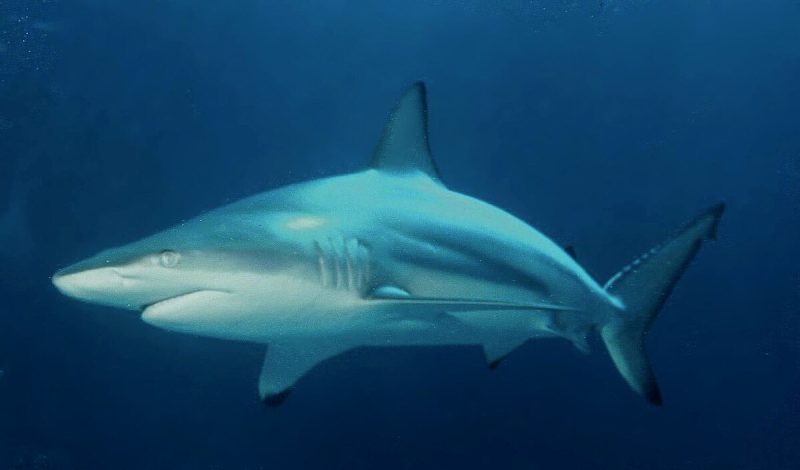
Blacktip shark is a fast and agile predator common in Florida’s coastal waters. It is named for the distinctive black tips on its dorsal and pectoral fins. Adults usually grow between 5 and 6 feet long but can reach lengths of up to 7 feet.
Identification features include a streamlined body, pointed snout, and the characteristic black tips on fins. Their coloration is generally gray on the back and white underneath, which provides camouflage in open water.
Blacktip sharks are found in shallow coastal waters, including bays, estuaries, and nearshore reefs. They are schooling predators feeding on fish, squid, and crustaceans. This species is popular among sport fishermen and poses little threat to humans.
Lemon Shark (Negaprion brevirostris)

Lemon shark is a large, stocky shark found commonly in Florida’s shallow subtropical waters. It is named for its yellowish-brown coloration, which provides excellent camouflage over sandy bottoms and reefs. Adults can grow up to 10 feet long.
Identification includes a broad, blunt snout, two nearly equal-sized dorsal fins, and a thick body. Their yellow coloring varies slightly depending on habitat, and they have small eyes relative to other sharks.
Lemon sharks inhabit mangrove estuaries, coastal bays, and shallow reefs in Florida. They are slow-moving predators that feed on fish, crustaceans, and stingrays. Lemon sharks are known for their social behavior, often found in groups or nurseries in protected waters.
Nurse Shark (Ginglymostoma cirratum)

Nurse shark is a bottom-dwelling shark common in Florida’s shallow waters. It has a stout body with a broad, rounded head and small, barb-like whiskers near its mouth. Nurse sharks usually grow up to 9 feet in length.
Identification features include a flat head, small eyes, and two dorsal fins set far back on the body. Their skin is rough, and they have a brownish color that helps them blend with the ocean floor.
In Florida, nurse sharks inhabit reefs, seagrass beds, and sandy bottoms, often resting during the day in caves or under ledges. They feed primarily on crustaceans, mollusks, and small fish, using their powerful jaws to crush prey. Nurse sharks are generally slow and harmless to humans.
Atlantic Sharpnose Shark (Rhizoprionodon terraenovae)
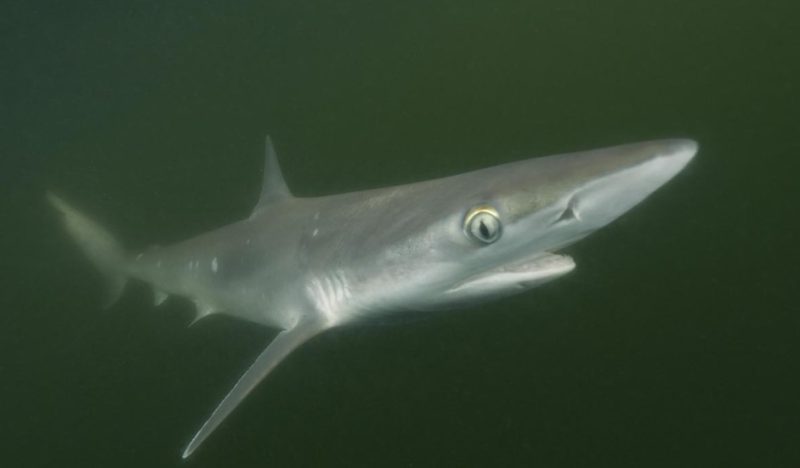
Atlantic sharpnose shark is one of the smaller shark species in Florida, rarely exceeding 3.5 feet in length. It has a slender body with a pointed snout and is known for its sharp, narrow teeth.
Identification includes a streamlined body with a relatively long, pointed snout and two dorsal fins without distinctive markings. Their coloration is typically gray to brown on top and white underneath.
This shark inhabits shallow coastal waters, bays, and estuaries in Florida. It feeds on small fish, crustaceans, and mollusks. The Atlantic sharpnose shark plays an important role in controlling small prey populations and is common in nearshore waters.
Sawfish (Pristis pectinata) – endangered
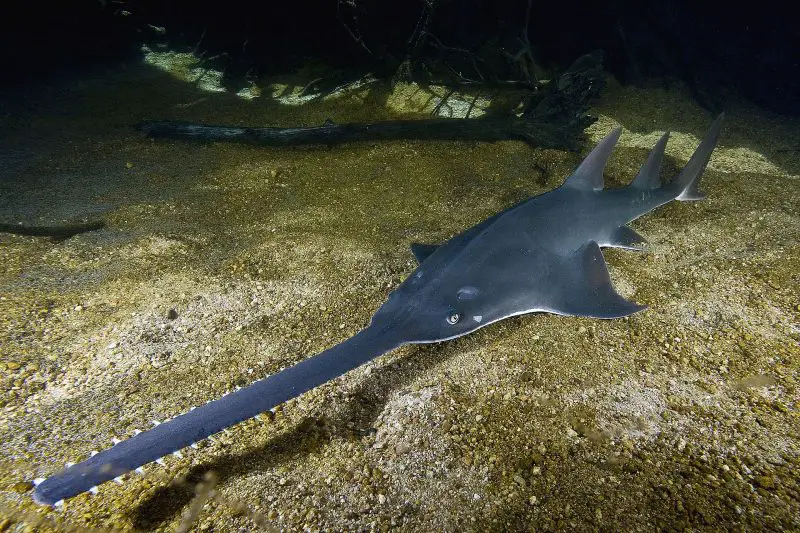
Sawfish is a rare and endangered species found in Florida’s coastal waters and estuaries. It is easily recognized by its long, flattened snout lined with sharp teeth, resembling a saw blade. Adults can reach lengths over 10 feet.
Identification features include a flattened body, broad pectoral fins, and a distinctive toothed rostrum used for hunting and defense. Their coloration is generally gray to brown on top and lighter underneath.
In Florida, sawfish inhabit shallow bays, estuaries, and mangrove-lined waterways. They use their saw to stun and capture prey such as fish and crustaceans. Due to habitat loss and fishing pressure, sawfish populations have drastically declined, and they are now protected under federal law.






